Tillandsia tenuifolia
Click thumbnails for full size, scaled to a new window.
Tillandsia tenuifolia
Scroll to bottom of page for discussion of types.
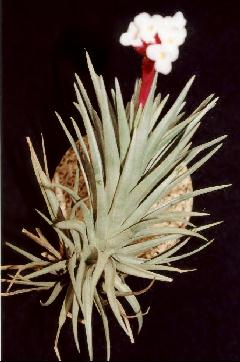
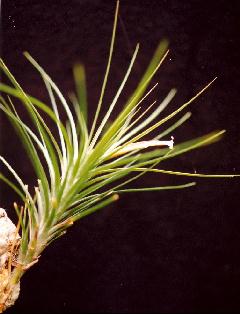
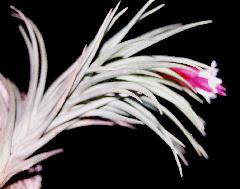
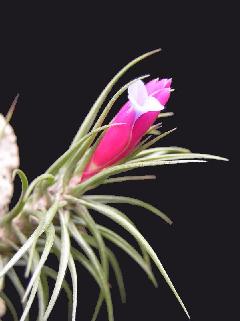
| White flowers. Ken Woods 08/04. (Ed. green bract = T. pardoi?) |
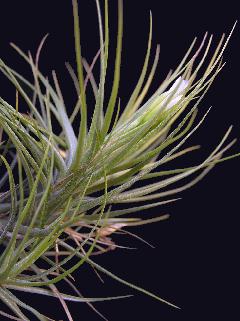
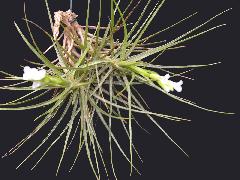
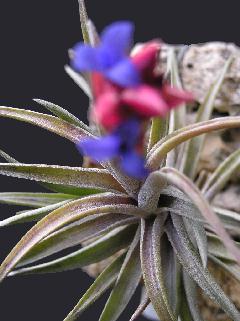
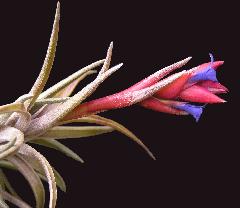
| White flowers. Ken Woods 08/04. (Ed. green bract = T. pardoi?) |
Blue flowers. Ken Woods. |
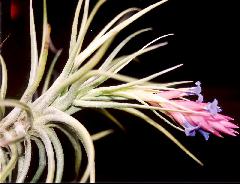
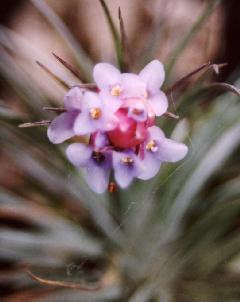
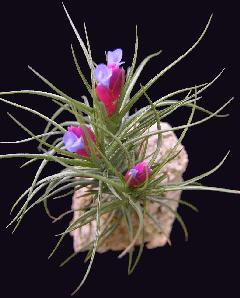
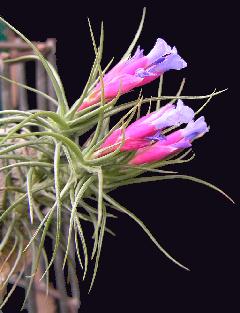

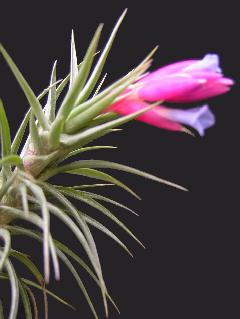


| David Sheumack. |
Ken Woods. Blue flowers. |


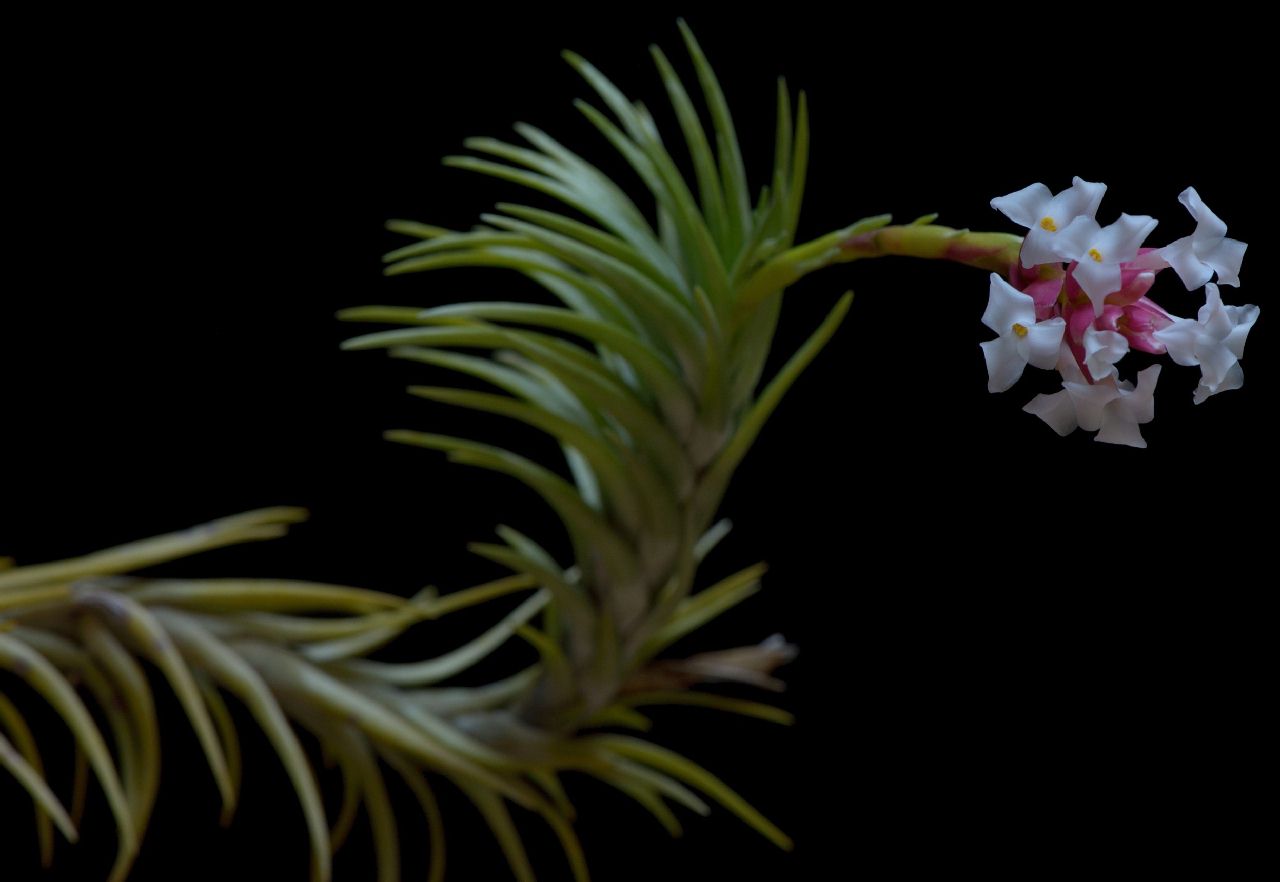
| Peter Tristram 11/14. |
Adam Bodzioch 11/14. |
George Nieuwenhoven 05/15, araujei ?
(See notes below.) |
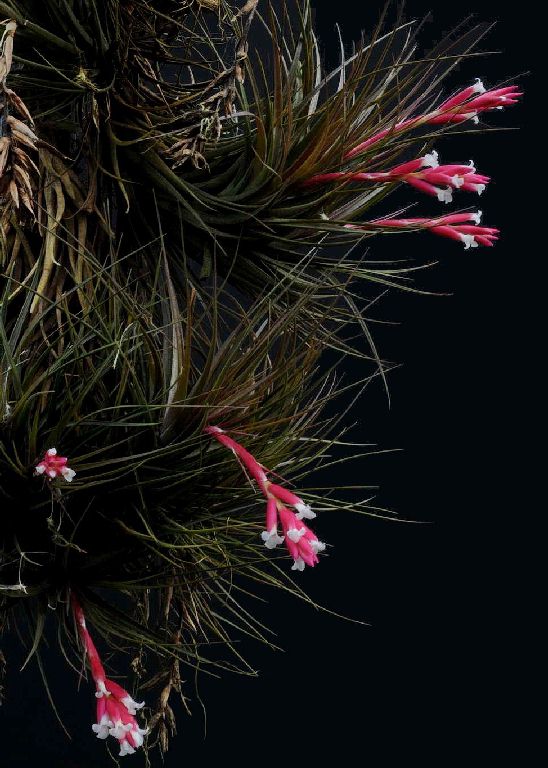
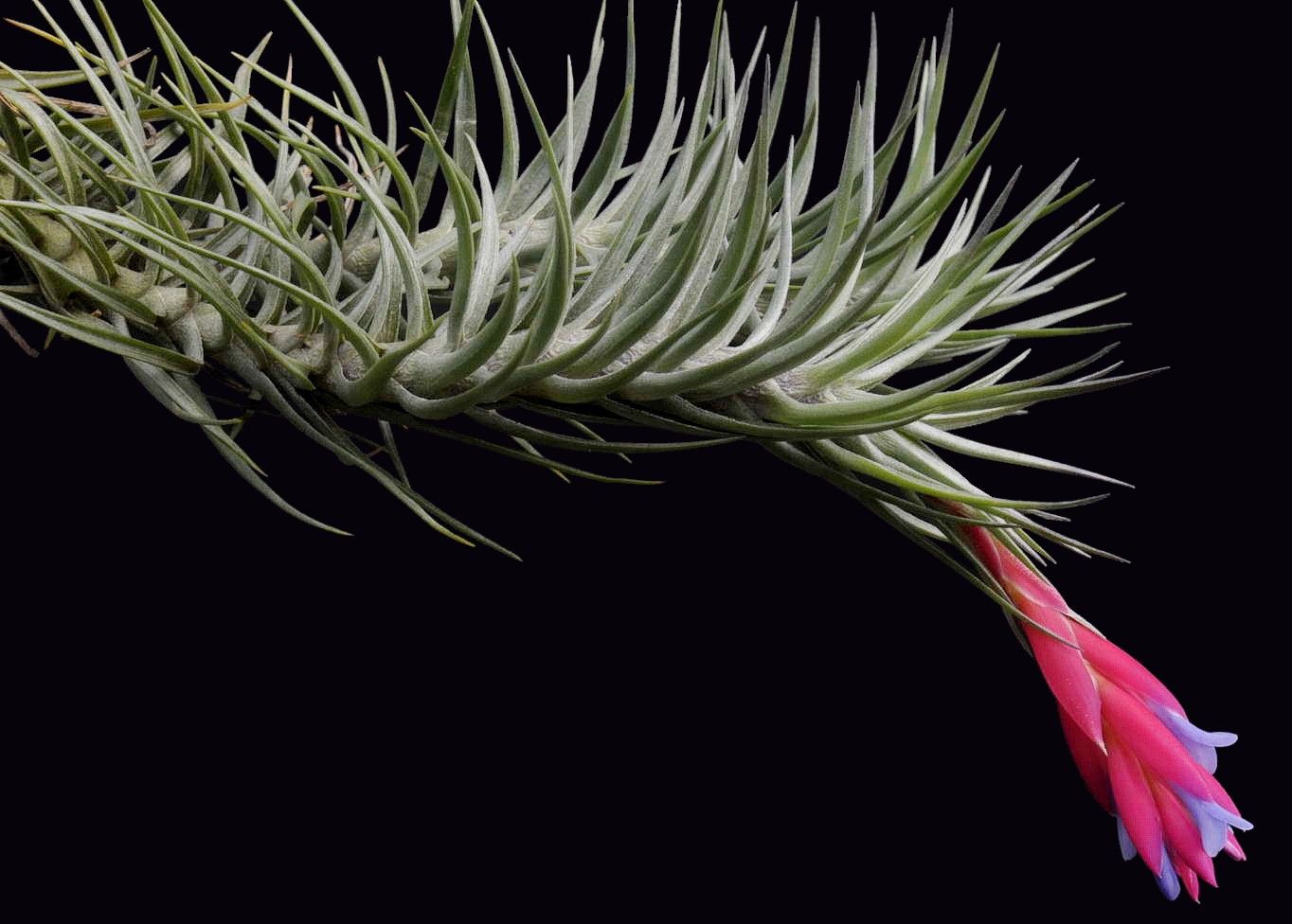

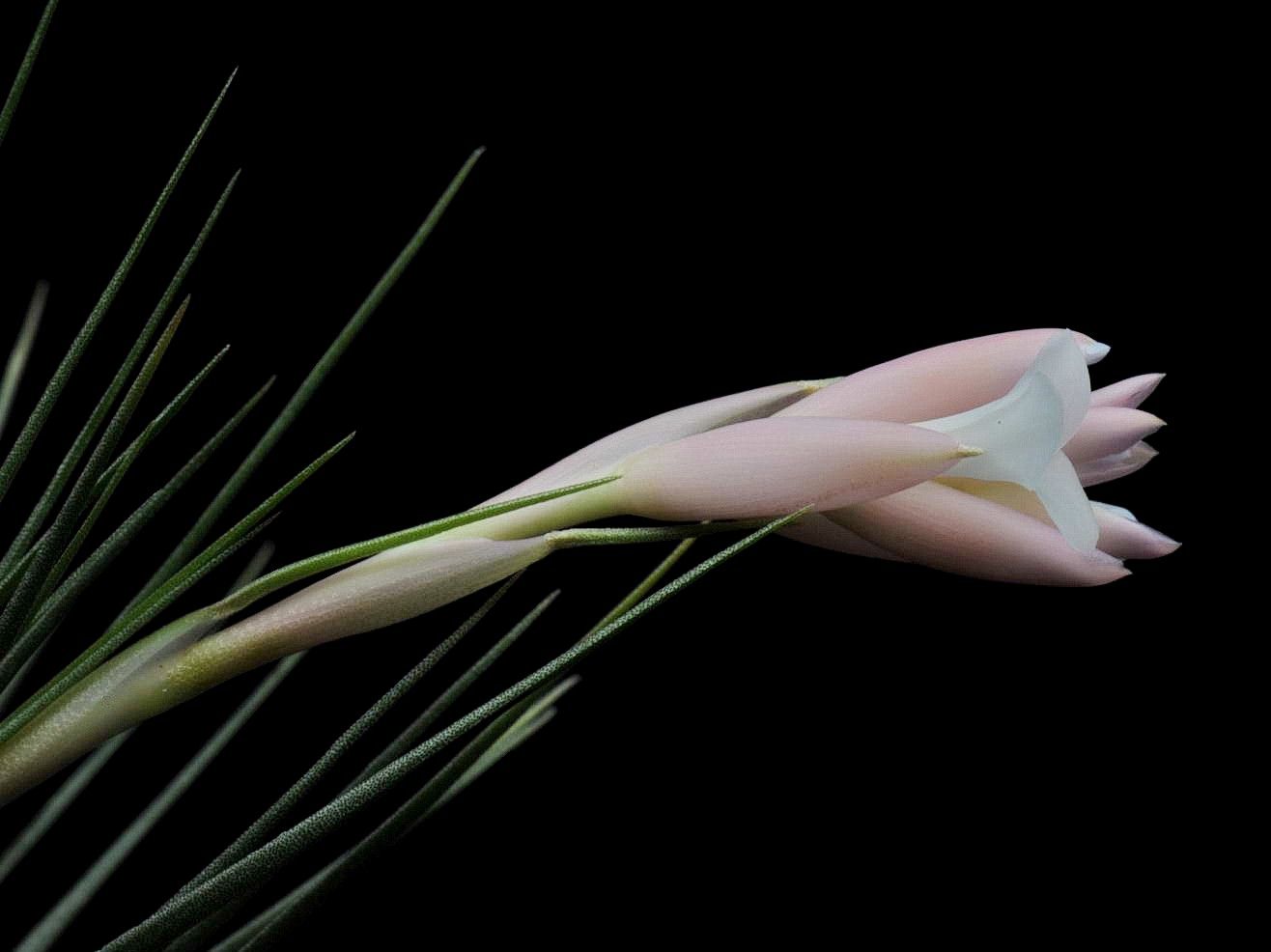
| "Amethyst" |
"Europe" |
"Pale" |
Tillandsia tenuifolia var. saxicola
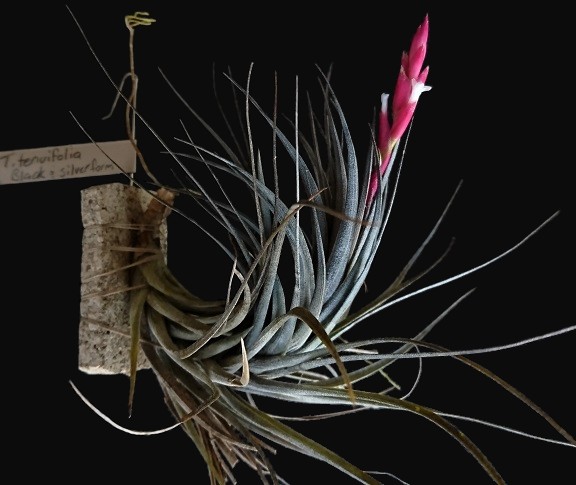

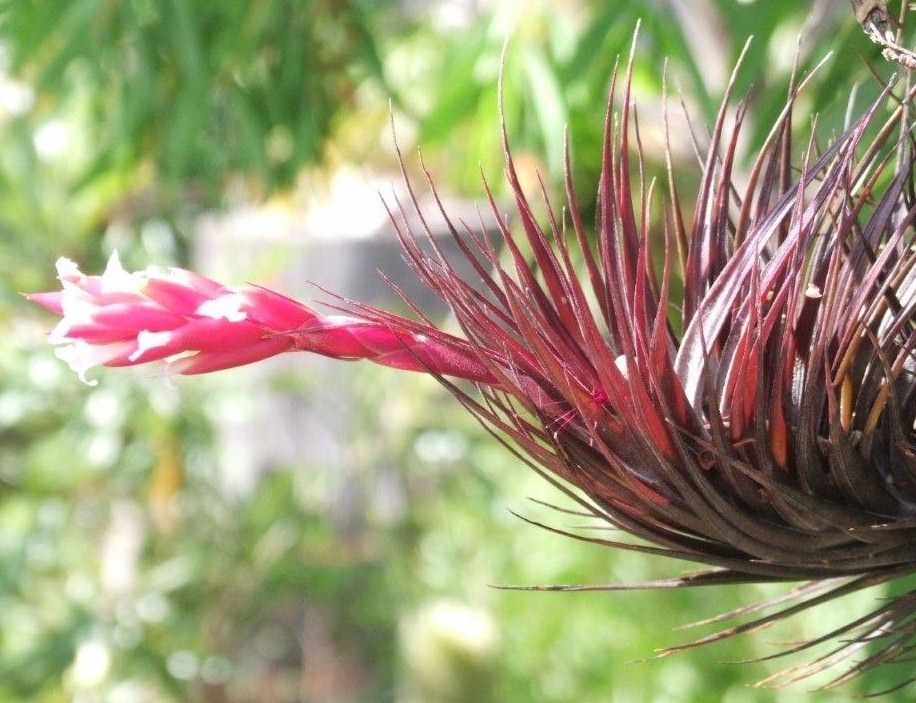
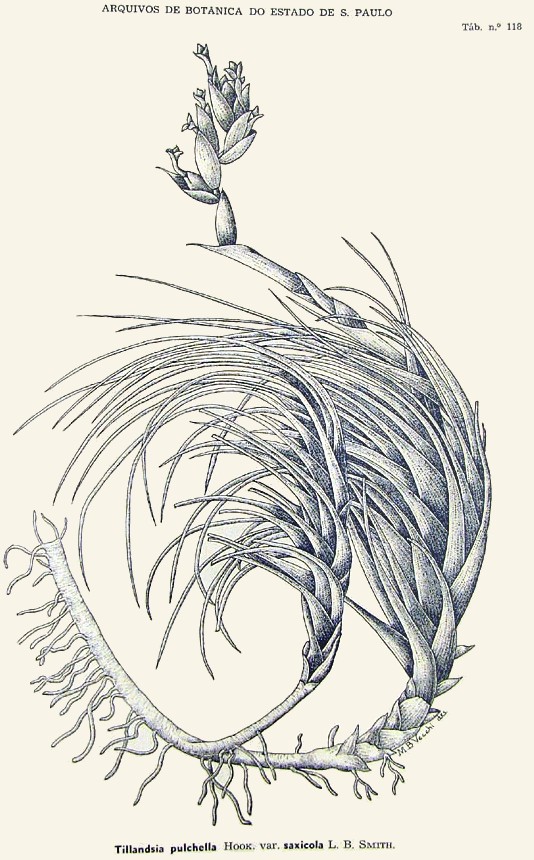
| Steve Molnar 11/17 as 'Black & Silver' form |
Rob Bower 11/17 |
Derek Butcher tenuifolia v. saxicola |
Steve Molnar ... "Not sure which type of T. tenuifolia this one is. It looks like one on Derek's disk as var. saxicola. I got it from the Olive Branch, and Olive said she got them from the USA from Bird Rock. Maybe Pamela Hyatt can confirm if this may even be T. tenuifolia `rubra' instead?"
Chris Larson ... "It is very close to T. tenuifolia Amethyst."
Derek Butcher ... "Yes, there are over 80 items of interest under tenuifolia to peruse. In other words a bag worms but no mention of 'Rubra' which seems to be an undefined sellers name (NN). On the disk you will see several under the name 'saxicola' to show that I was not certain of its accuracy because of lack of analysis or where it had been found in the wild.
I suggest you just call T. tenuifolia unless you are prepared to dissect and compare using the key used by botanists. Don't forget the many hybrids that have no doubt been done over the years and not disclosed."
Rob Bower ... "pic above is the tenuifolia that I had been calling 'Rubra' until various experts told me it was Amethyst."

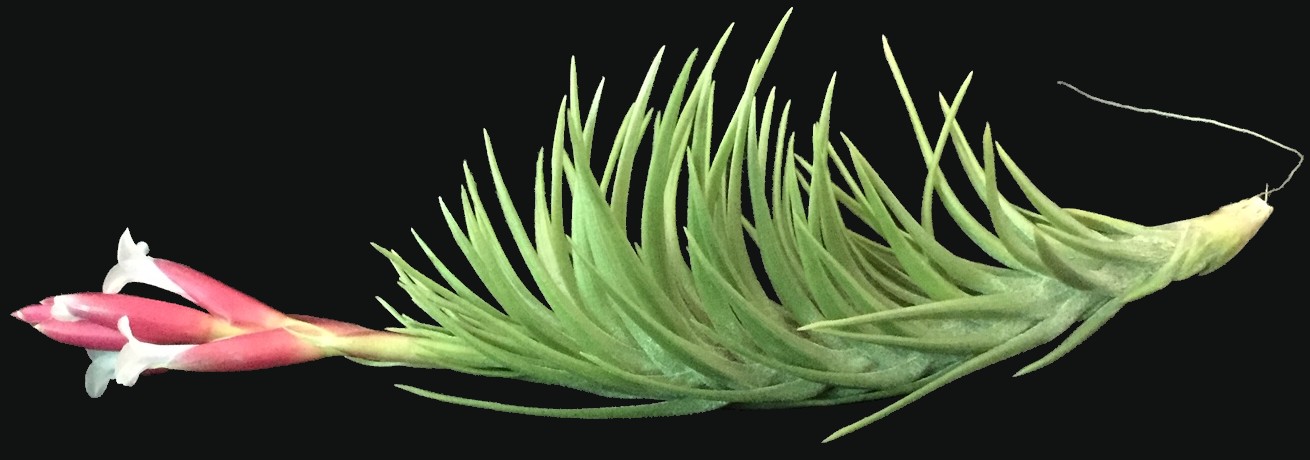
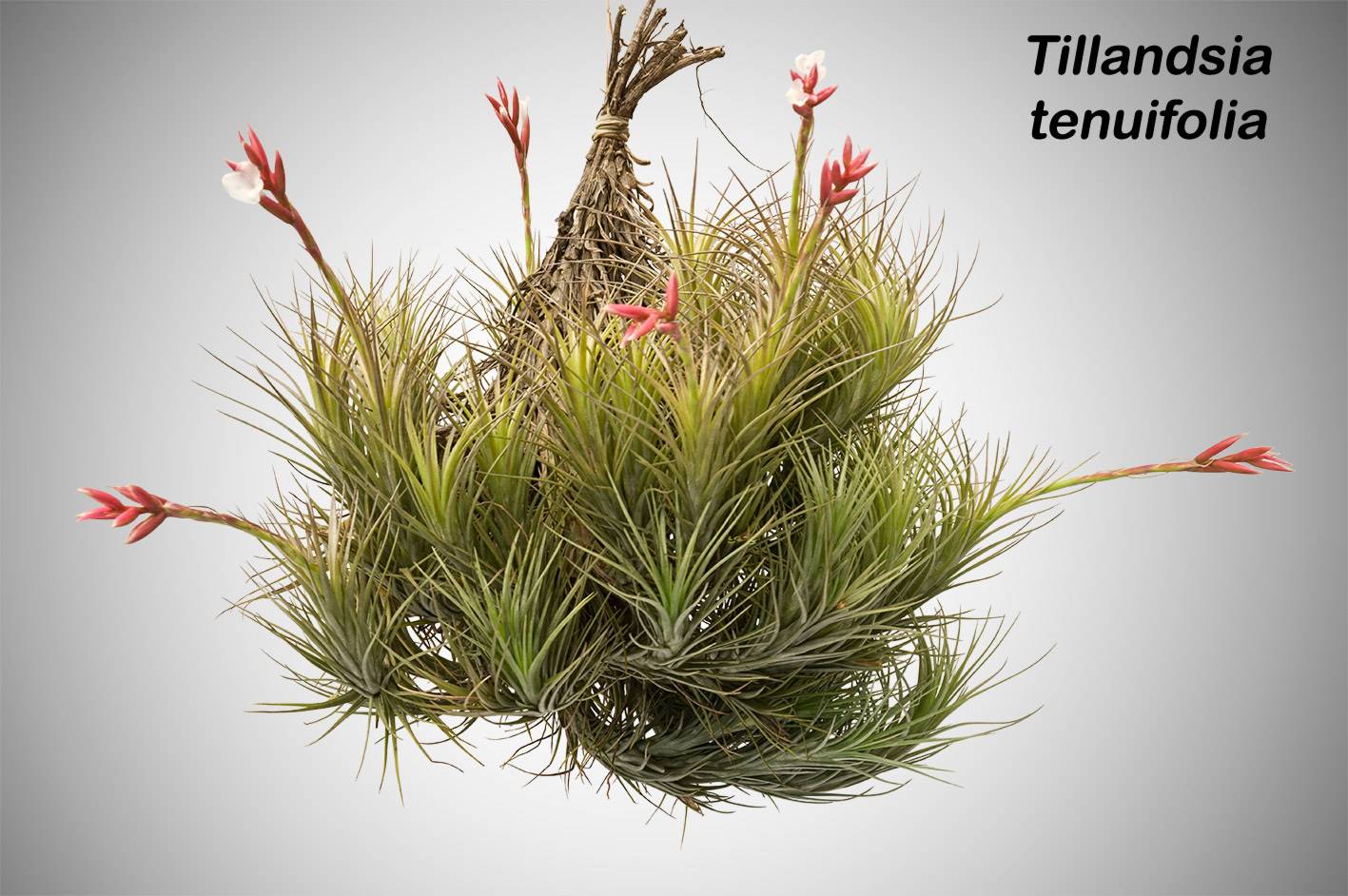
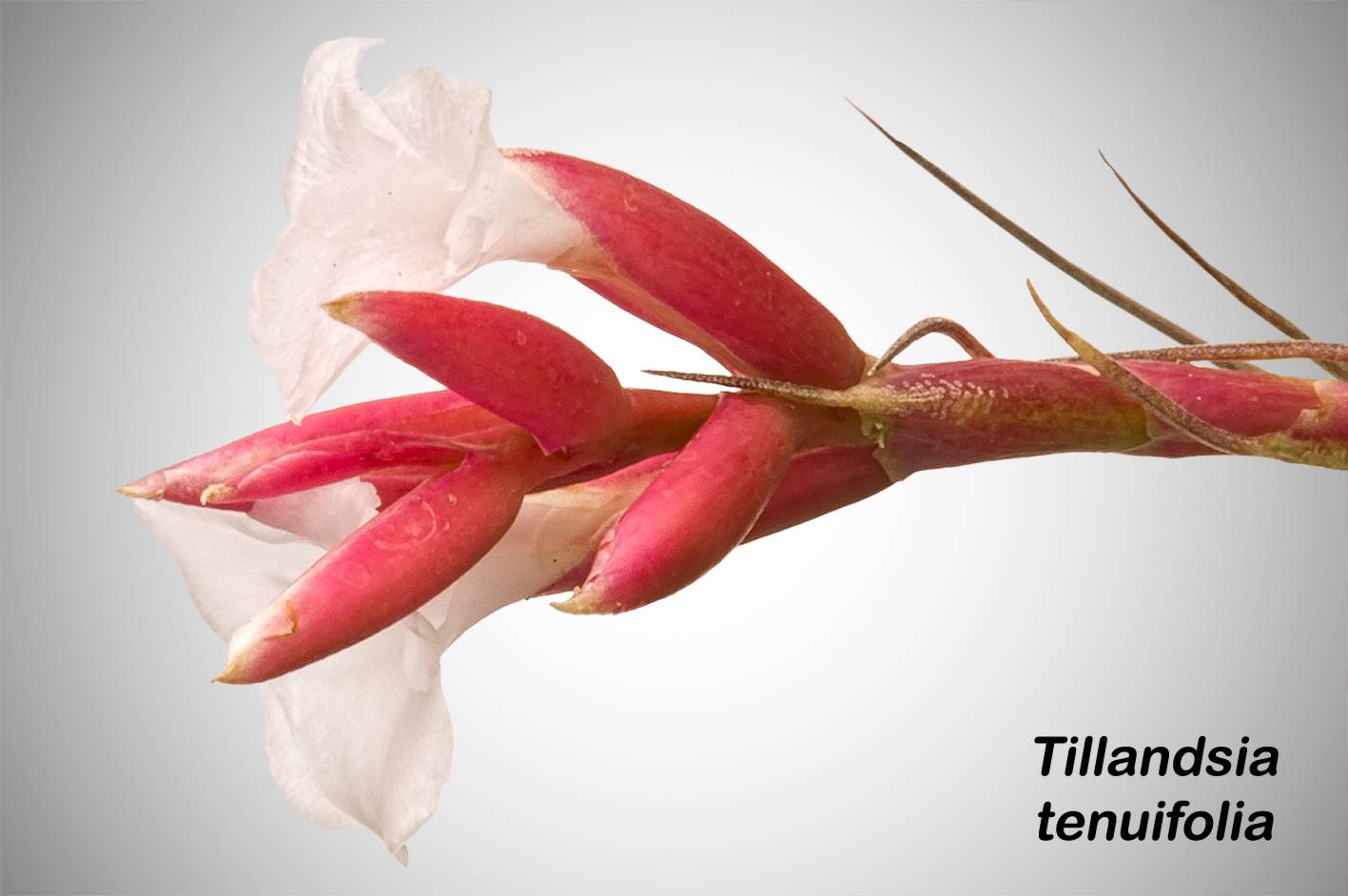
| Jenny Brittain 02/19 ex. Chris Larson |
Vic Przetocki 09/22 as saxicola, maybe vaginata ? |
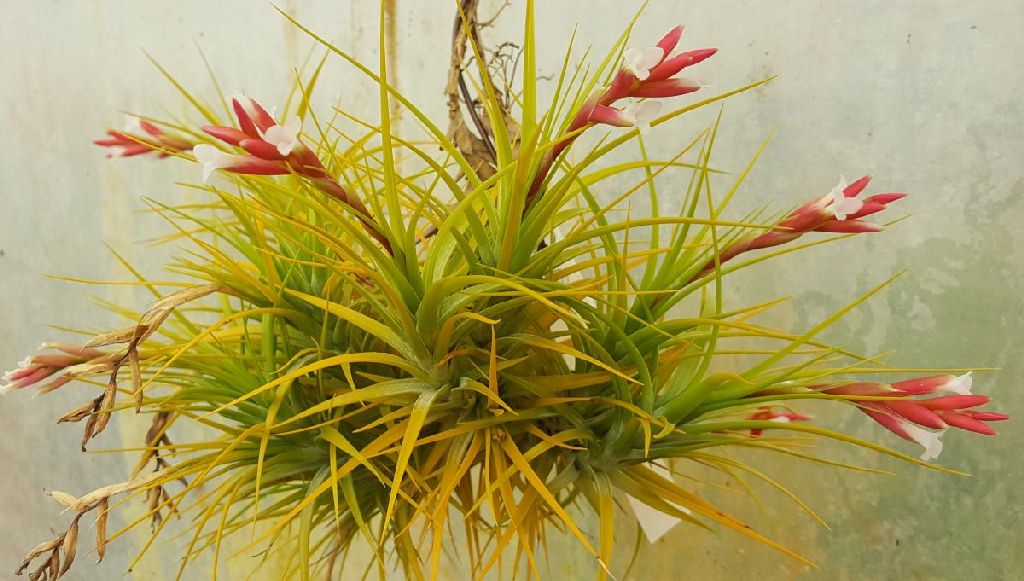
| Chris Larson 12/18 ex. Diamentina |
Chris Larson ... "tenuifolia from Diamentina in Brazil. From our last import in 2014 before the big changes. It has always been this stressed yellow culture – high light, low light no difference. It has fertilizer every week with the rest."
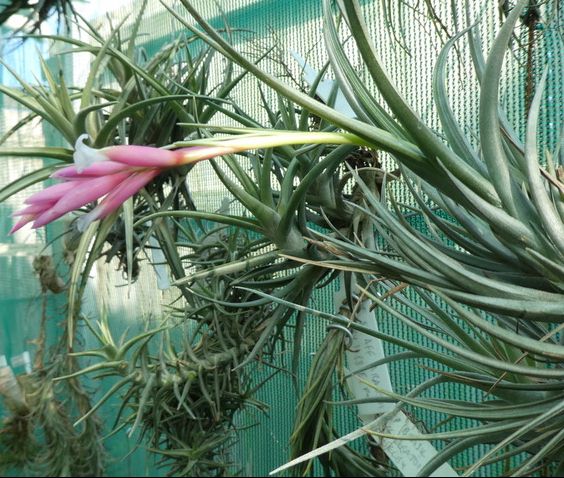
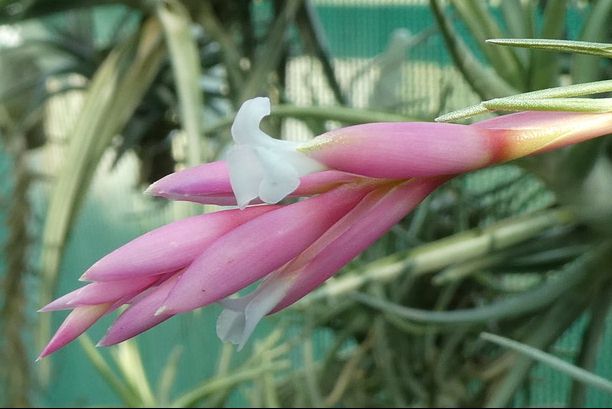
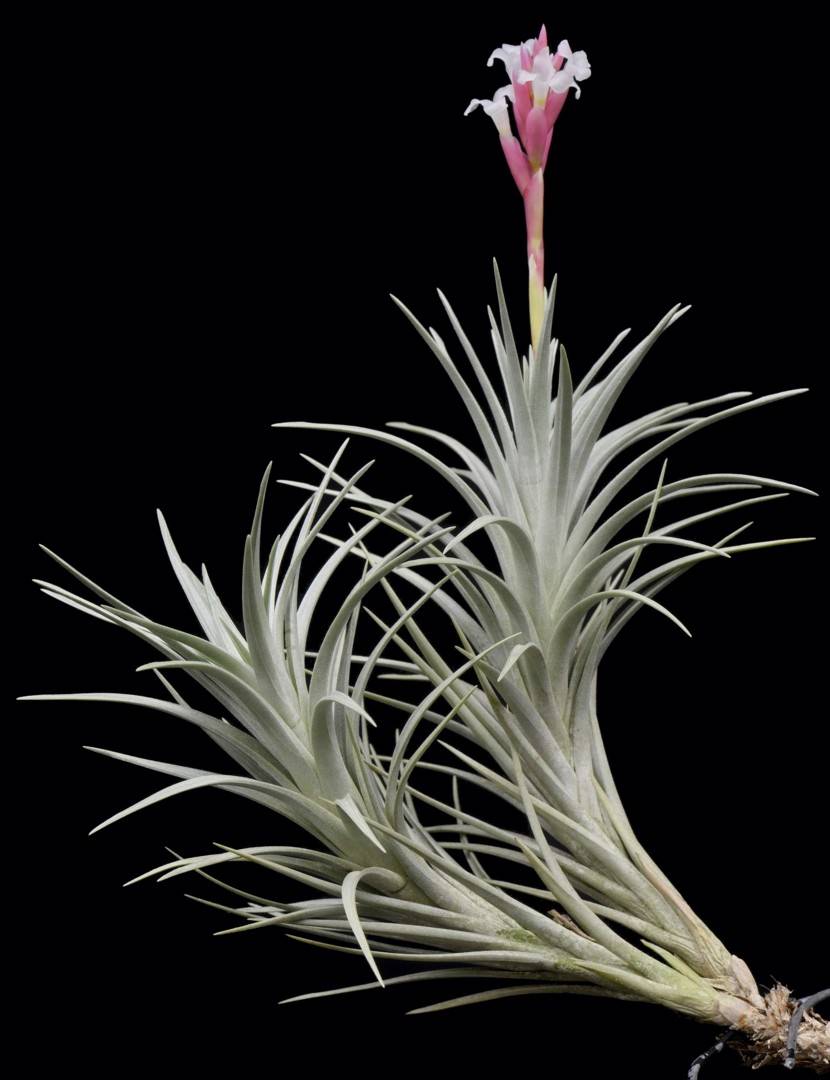
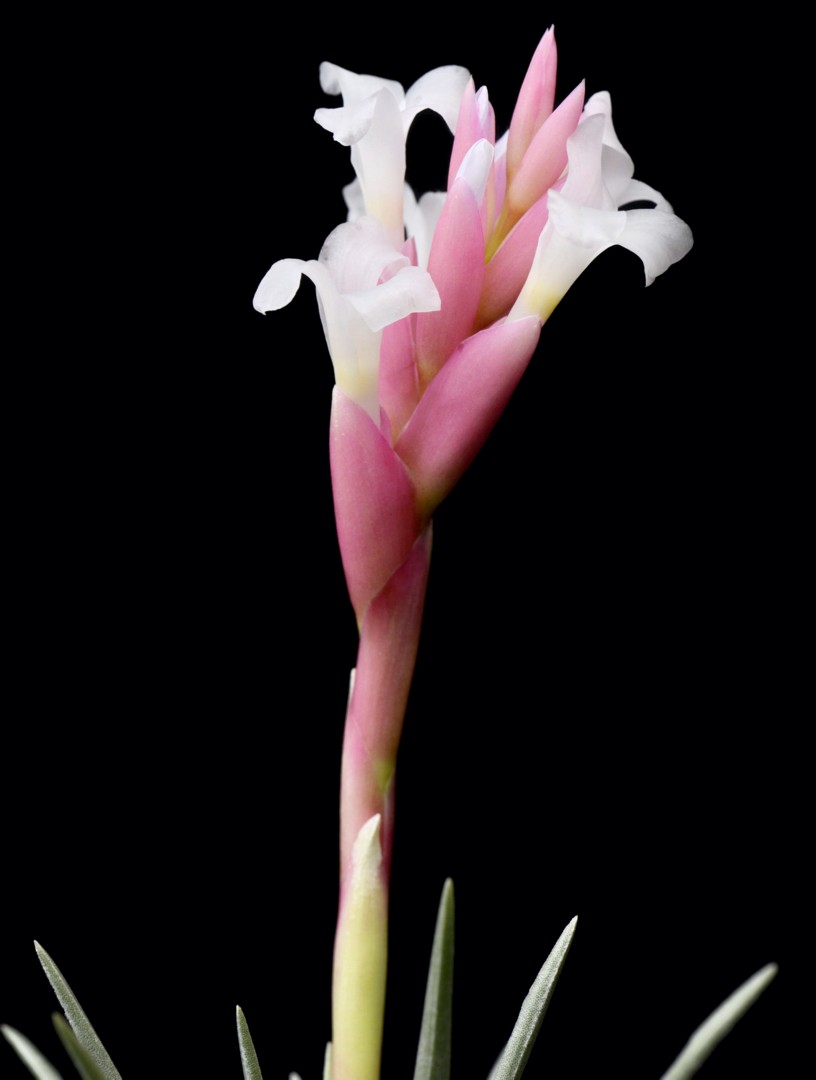
| Bruce Dunstan 09/20. from T. albertiana type locality ex Chris Larson |
Peter Tristram 05/21 Hard leaf, Holm |
Peter Tristram ... "There are so many inselbergs in eastern Brazil with so many hard-leafed 'tenuifolia' forms! araujei comes to mind too. Occasional very distinctive ones are described, like milagrensis, or were to be described, like cocoensis. I'll go looking for the parent clump of this hard leaf form, from Holm, but I don't think I have any other info."
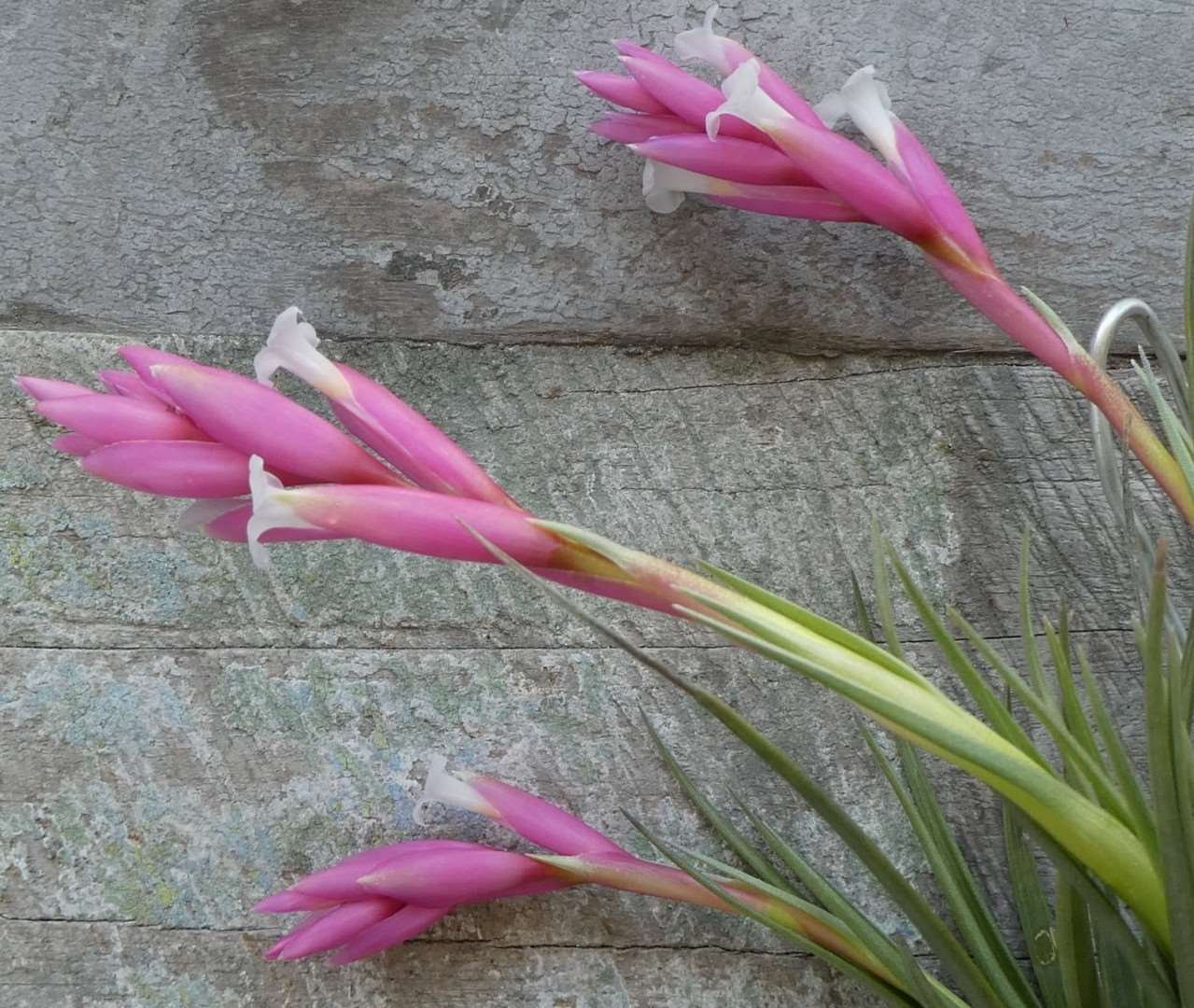
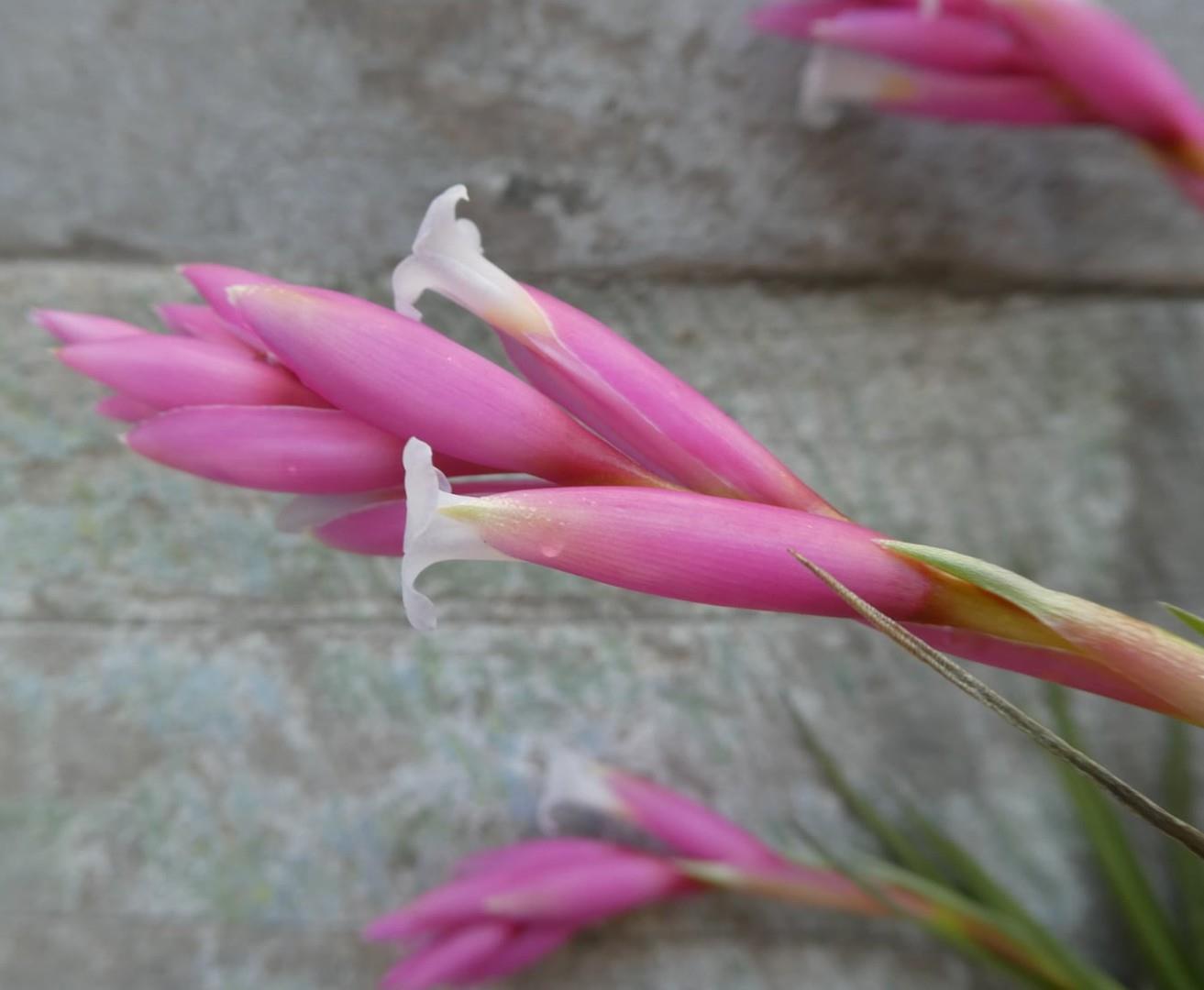
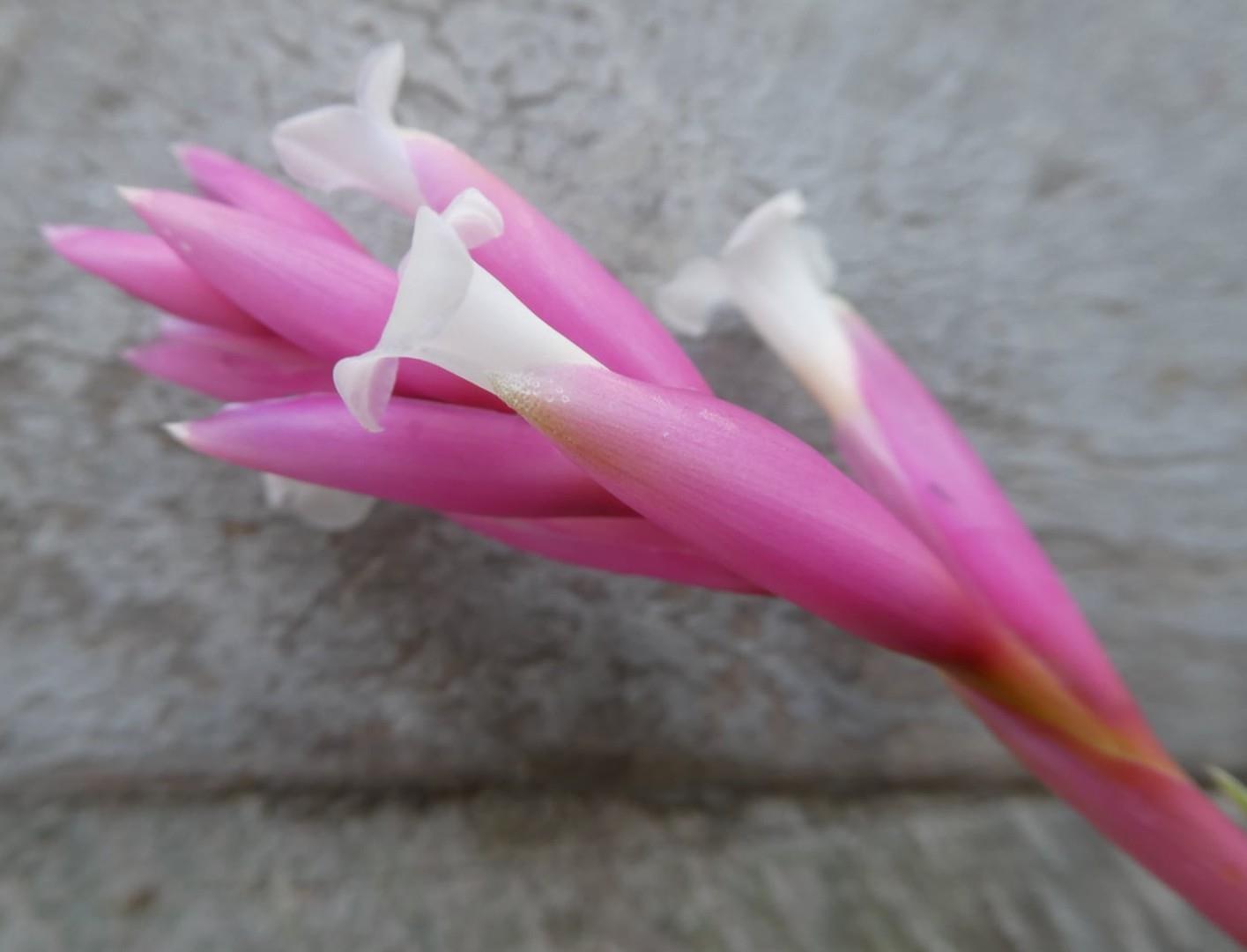

| Bruce Dunstan 08/21 ex. Chris Larson |
Bruce Dunstan ... "Tillandsia tenuifolia from the type locality of T. albertiana on rocky banks, near El Potrerillo (Ruta Nacional no.9, km 1418), Rio Grande del Sauce, Candelaria, Salta, Argentina."
Chris Larson ... "We'll done Bruce. Found growing in a narrow river valley on short trees with T. usneoides, peperomias and ferns. Within sight of T. albertiana, T. australis & Deuterocohnia brevifolia & D. longipetala on the cliffs. The D. brevifolia in this valley was growing in a wet environment.
The memories! 25 years ago."
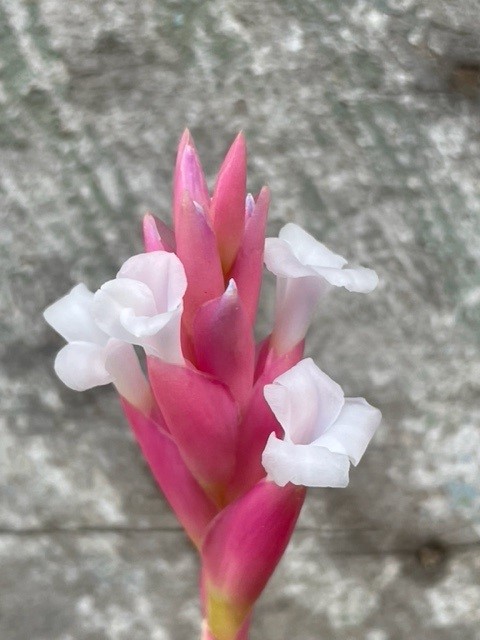


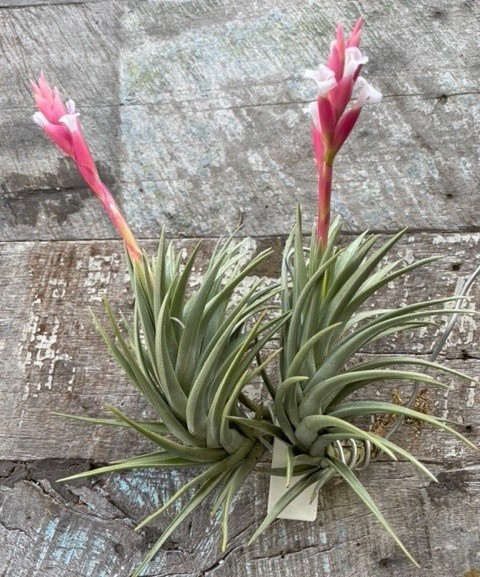
| Bruce Dunstan 04/22 'Hard leaf' form |
Tillandsia tenuifolia var. strobiliformis
Now Tillandsia tenuifolia var. tenuifolia by Gouda
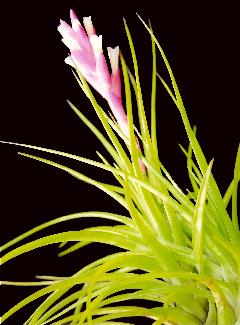
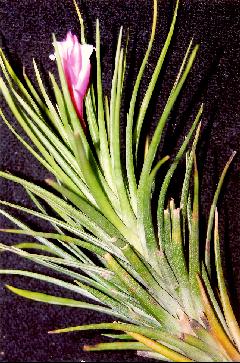
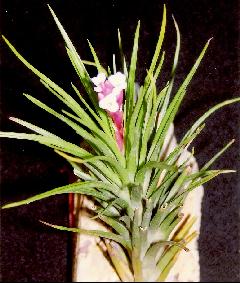
| var. strobiliformis. Ken Woods. |
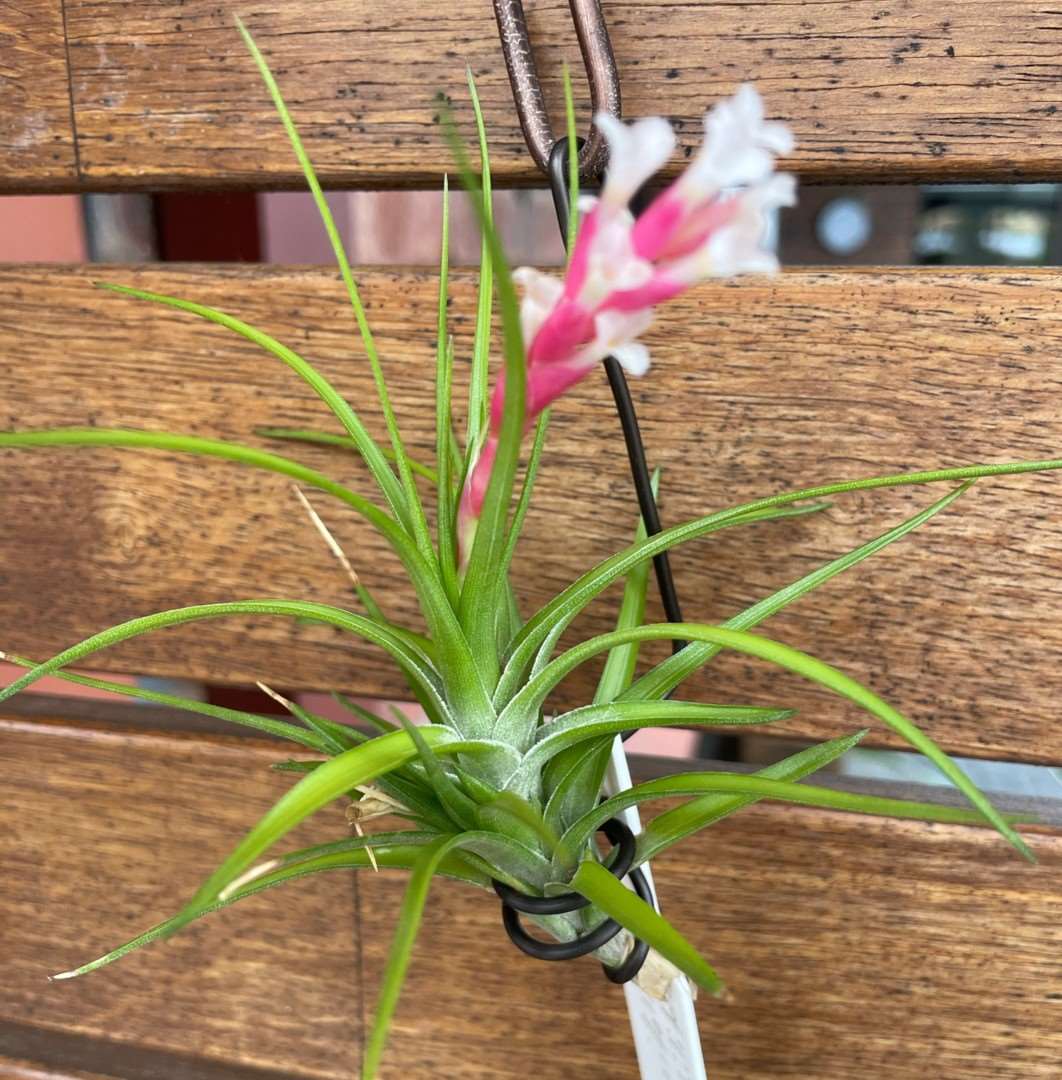
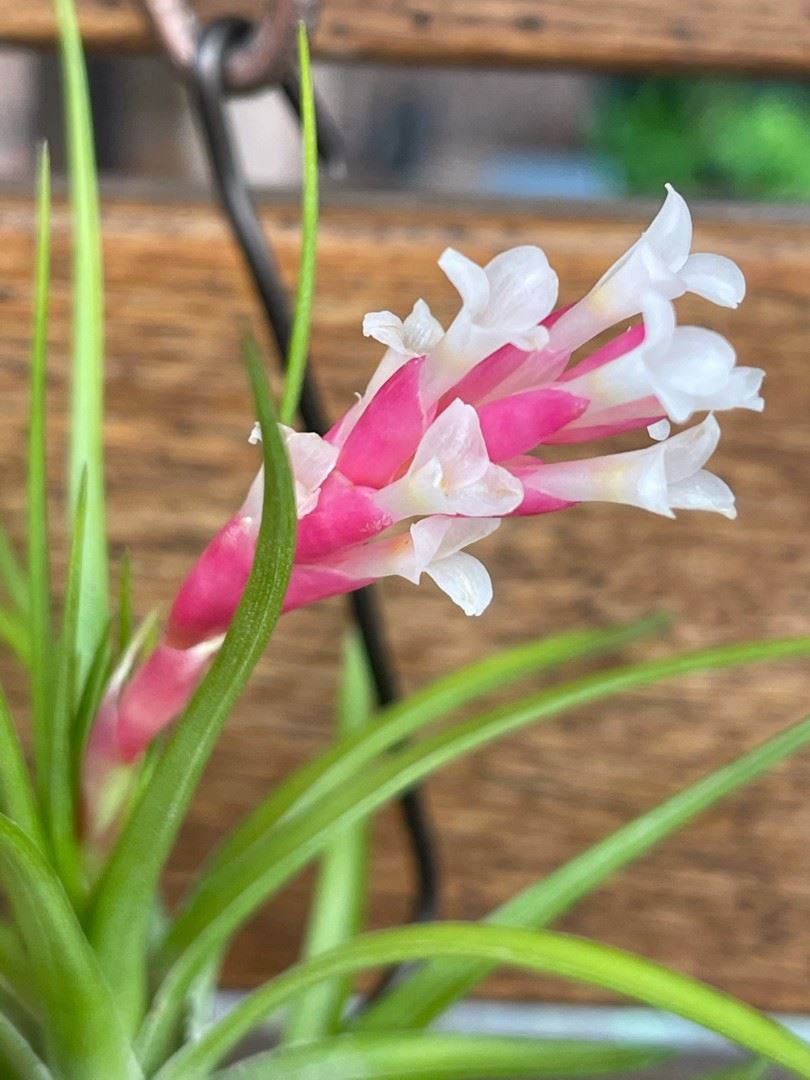
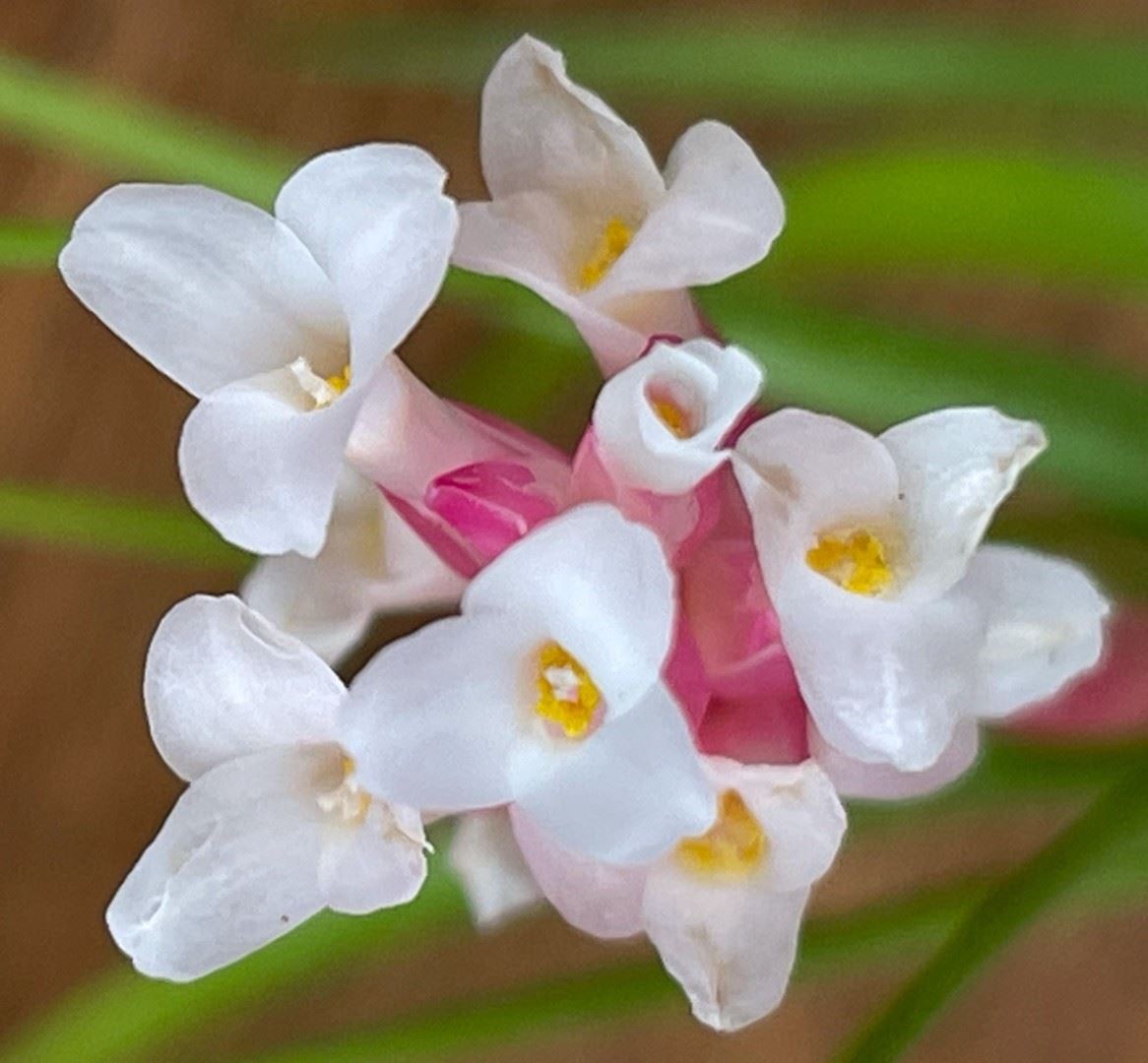
| var. strobiliformis Ray Clark 02/21 |
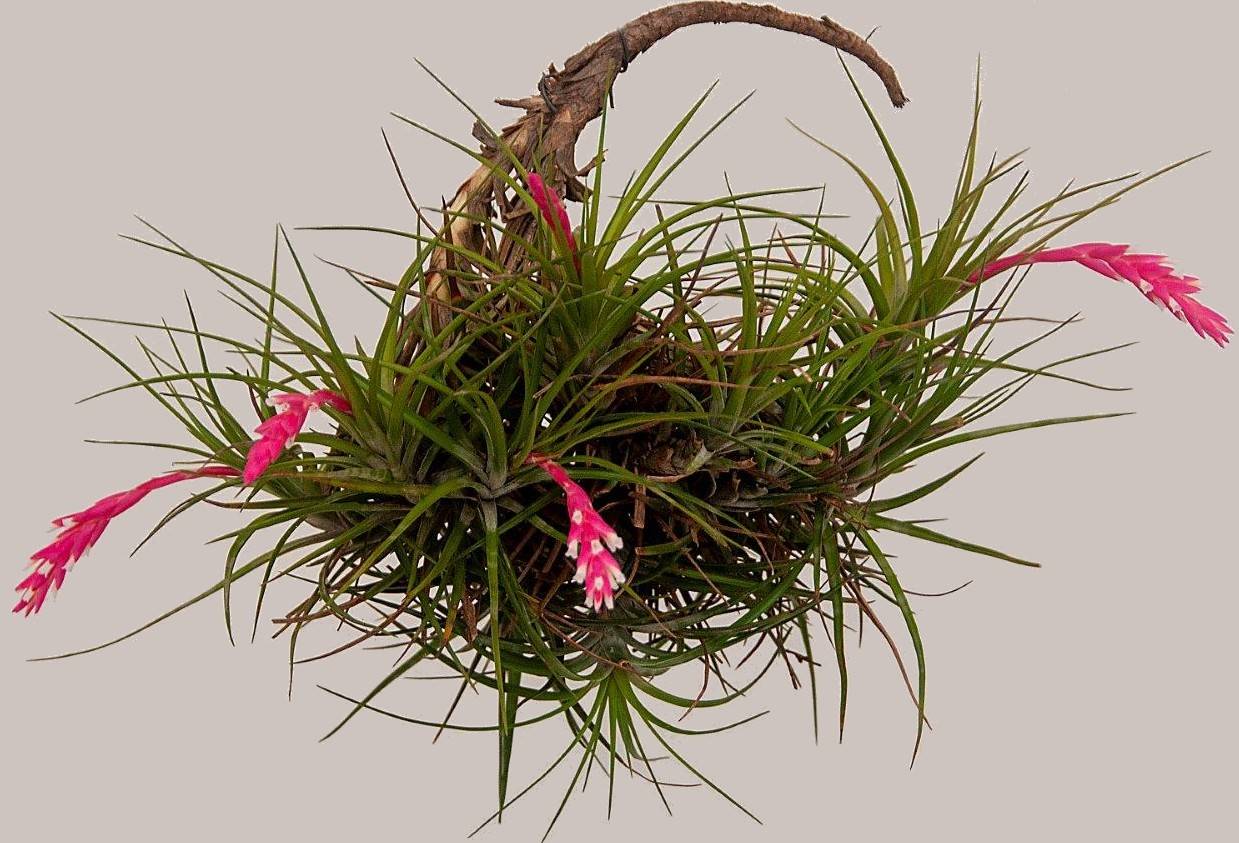
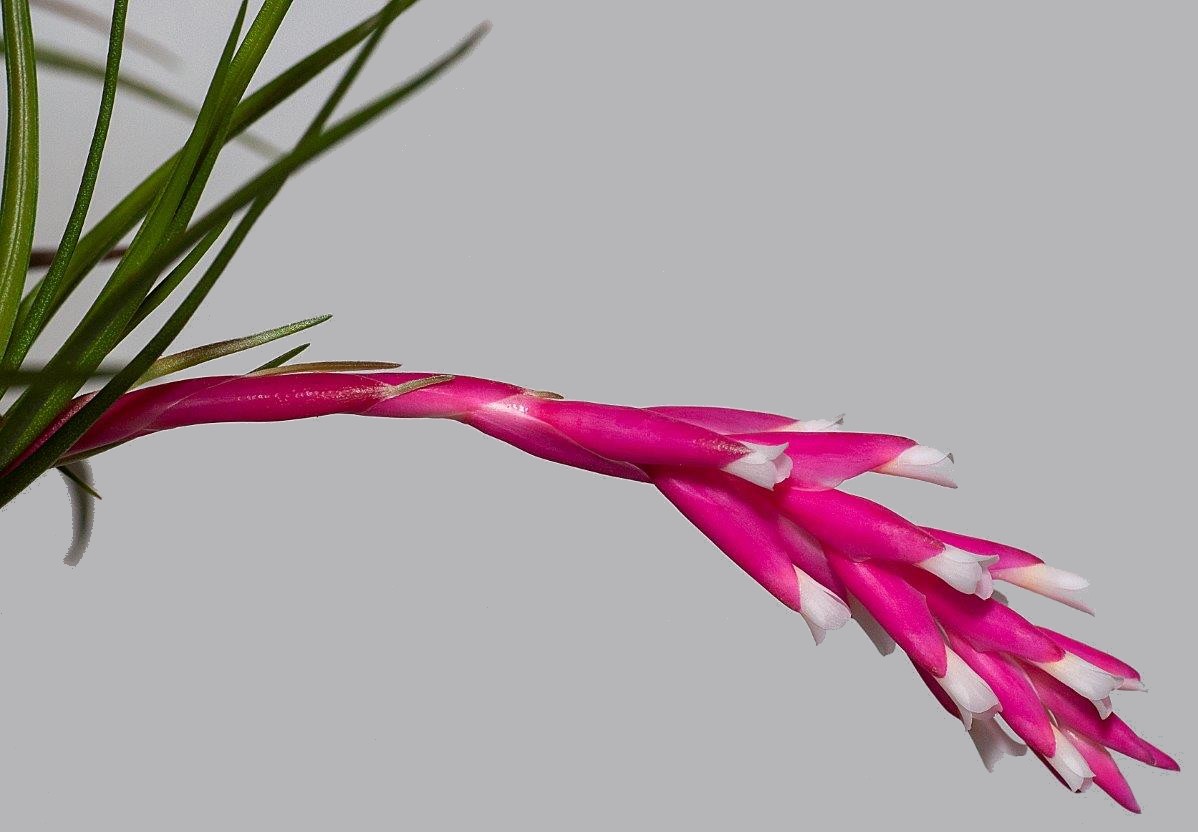
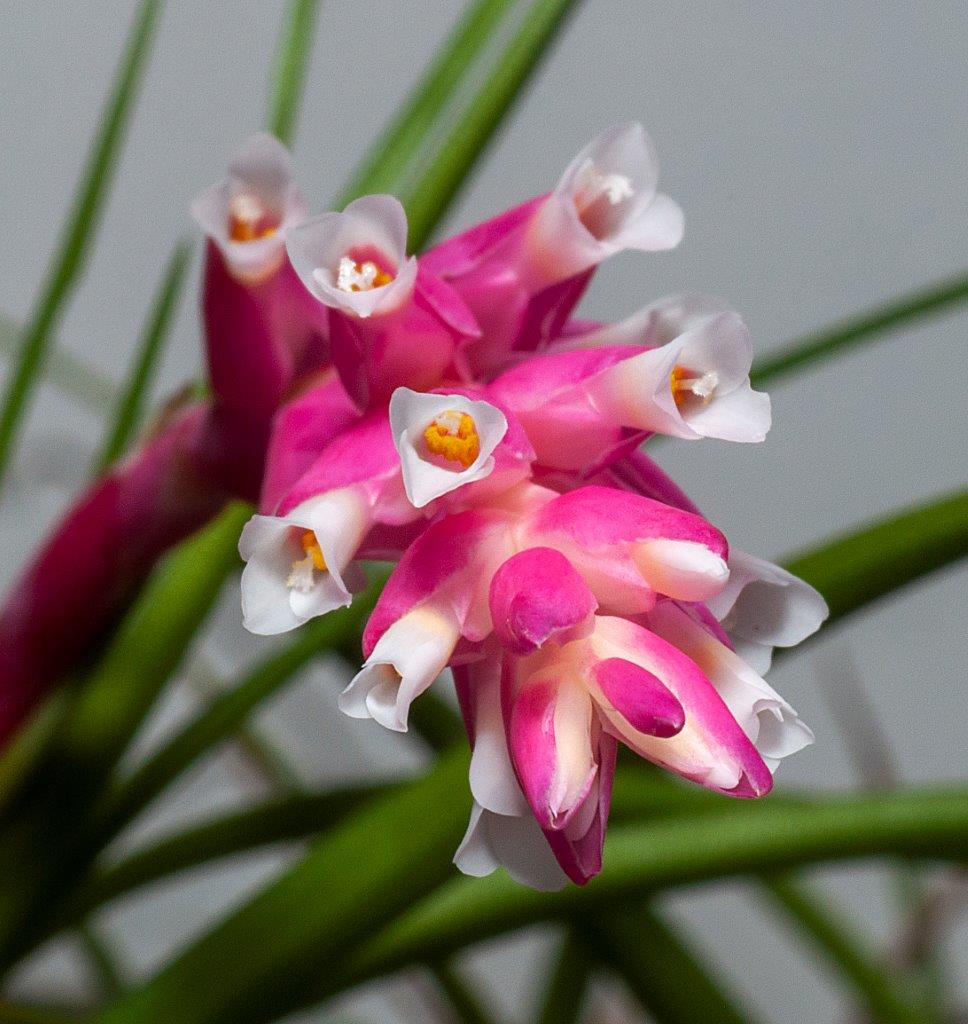
| var. strobiliformis ?? Rob Bower 02/21 |
Tillandsia tenuifolia var. surinamensis
Then just Tillandsia tenuifolia var. tenuifolia by Gouda
Now probably tenuifolia var. nigrifolia see Gouda 2017 notes below and Die Bromelie 1: 2017.
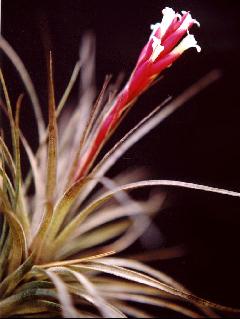
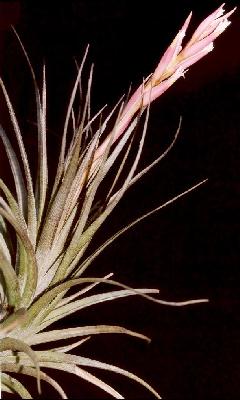
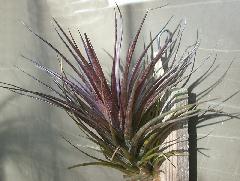
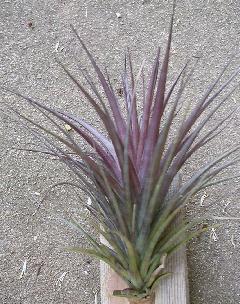
| var. surinamensis. Ken Woods. |
var. surinamensis. Ian Hook 10/05. |
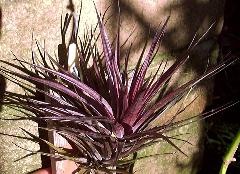
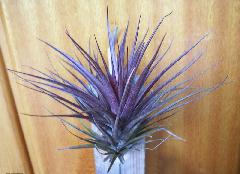
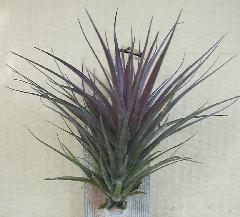
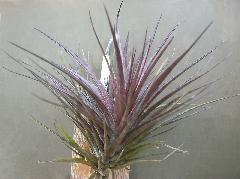
| var. surinamensis. Ian Hook 10/05. |
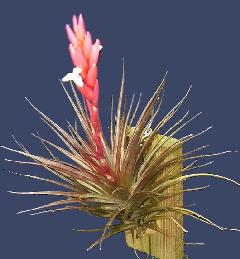
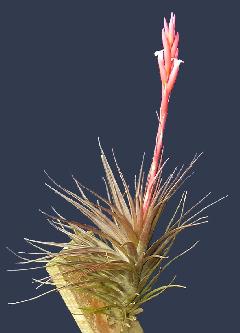


| var. surinamensis. Ian Hook 12/05 |
Gary May 11/24 as 'Rubra' |
Ian Hook ... "Gary: Chris Larson spotted that one of mine and declared it tenuifolia var. surinamensis. I just looked at BSD again and found no such thing, but there is a var. nigrifolia. Then checking the taxon list... I see var. surimanensis has been moved into synonomy with var. tenuifolia."
Ian Hook ... "upon further checking notes on BinA. Gouda's article in Die Bromelie 1: 2017 would indicate it's now called var. nigrifolia. Particularly if it tends towards some orange tinge towards base of floral bracts."
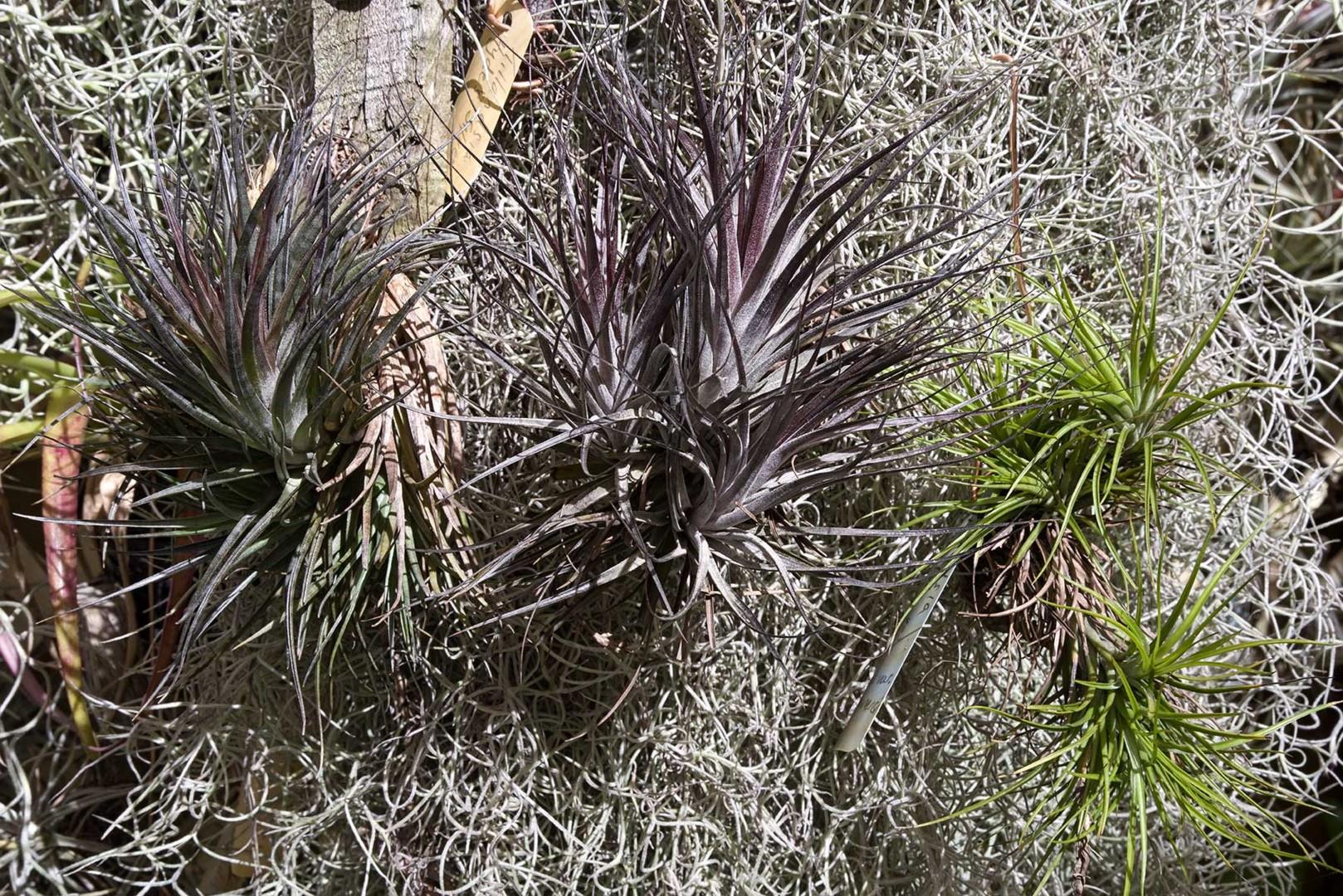
| Vic Przetocki 11/24 Amethyst / Rubra / surinamensis |
Vic Przetocki ... "I have both 'Amethyst' and tenuifolia "Rubra", I can't see a lot of difference between them. I have now put them side by side to see if they grow and colour differently. The photo from left to right T. Amethyst (ex Derek Butcher), tenuifolia "Rubra" (acquired from a local grower) and what I got a long time ago as tenuifolia var. surinamensis which is now treated as var. tenuifolia."
Tillandsia tenuifolia var. vaginata (see notes below)
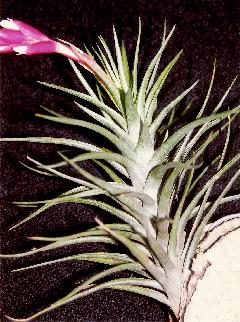
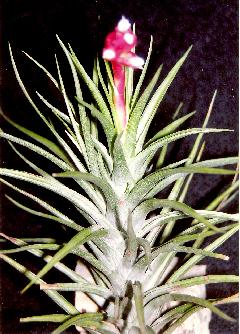
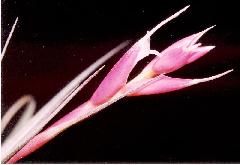
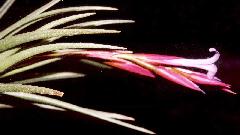
| var. vaginata (???) Ken Woods 06/05 |
Ken Woods. Uncertain varieties. |
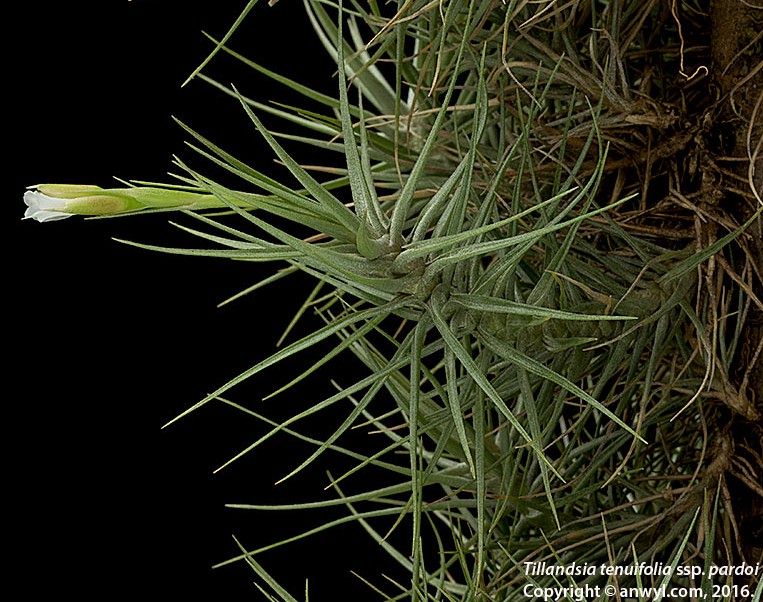
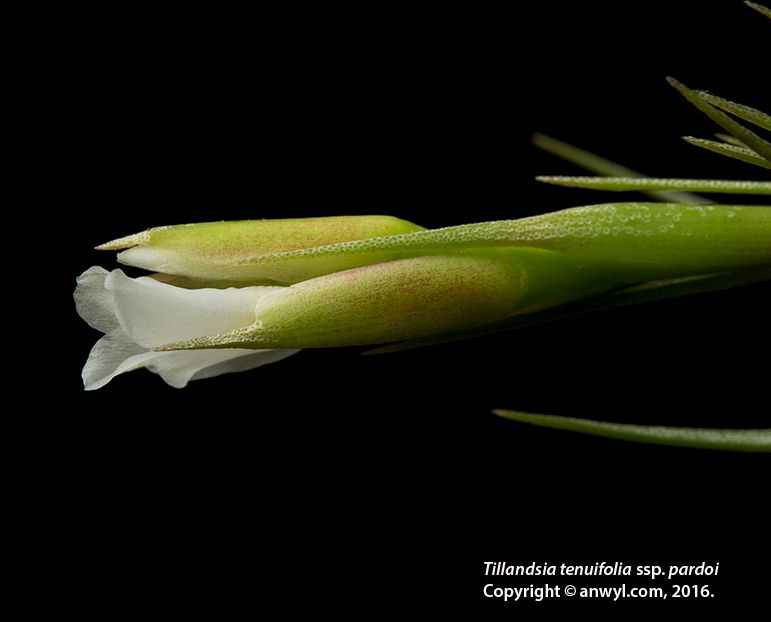
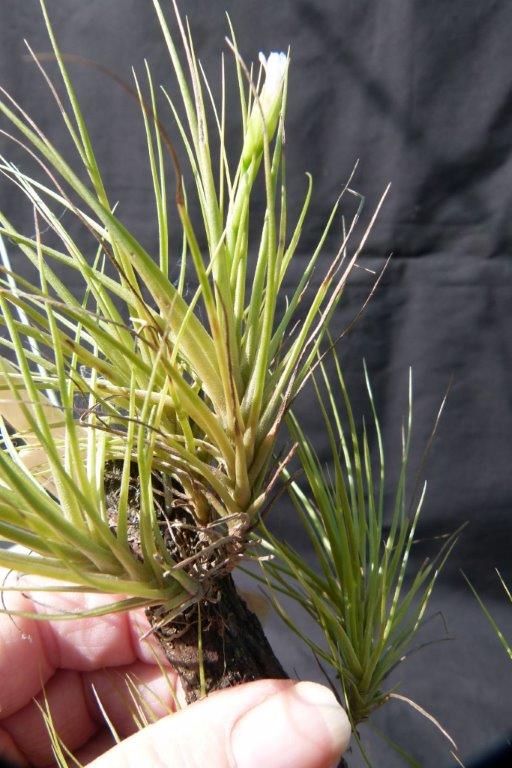
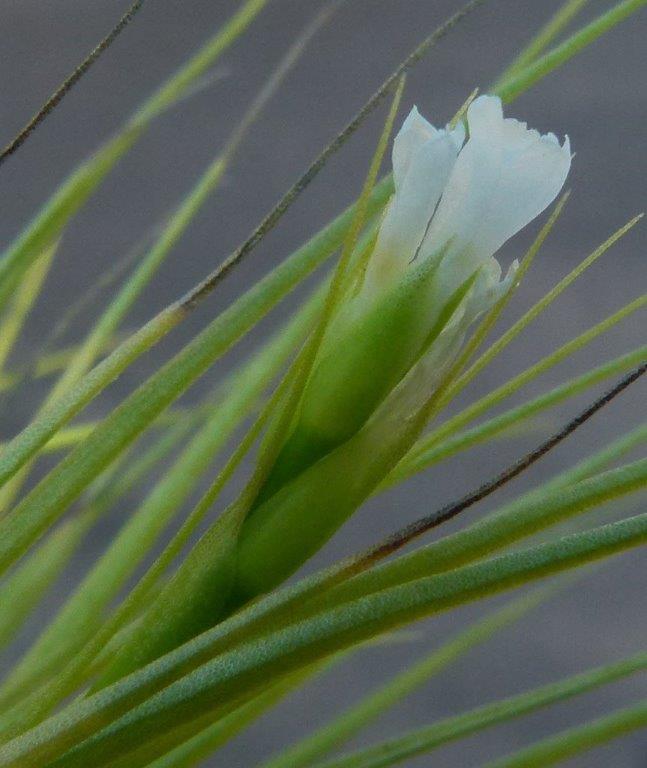
| Andrew Flower 06/16 as tenuifolia ssp. pardoi |
T. pardoi Nanette Collingwood 06/16 |
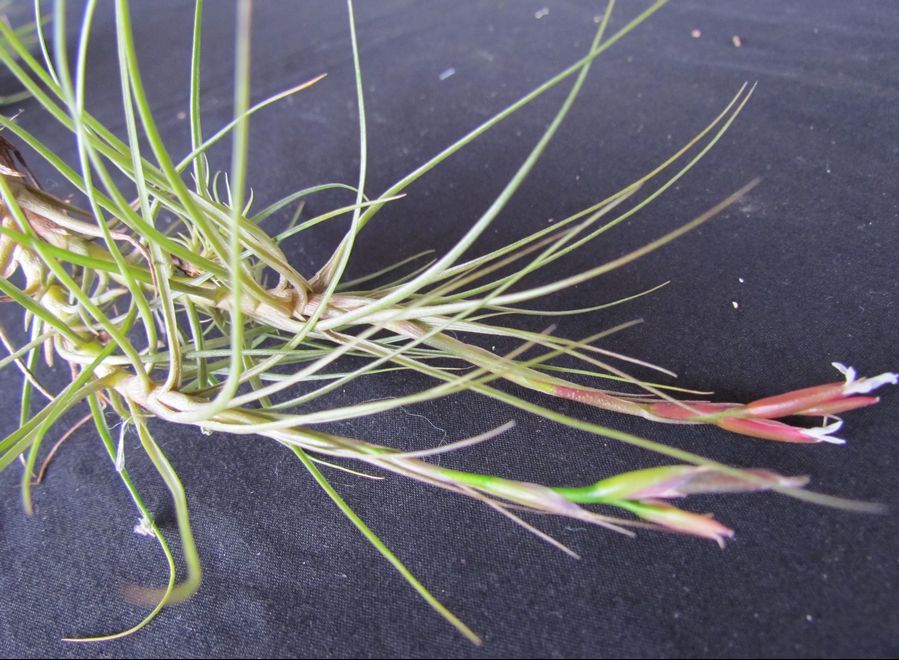
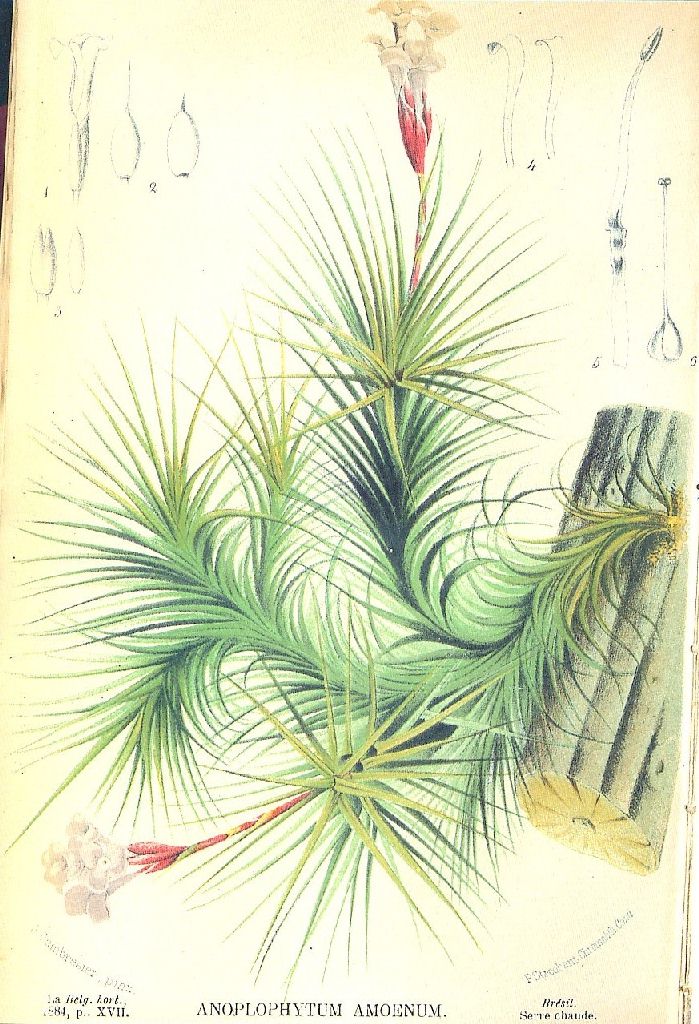
| tenuifolia v. vaginata Kerry McNicol 07/16 |
tenuifolia v. vaginata Derek Butcher |
Nanette Collingwood 28/06/16 ... "This little 10 cm (4 inch) plant came as a hitchhiking seedling on a plant purchased in 2012. It has similar looking siblings, which I mounted altogether onto a stick in 2013. I was very surprised to see it flowering on the weekend - a tiny white tube flower, with green sepals and floral bracts. I haven't been able to key it to anything, and have difficulty guessing at its parents.
Any ideas anyone???"
Andrew Flower 28/06/16 ... "Looks like Tillandsia pardoi (Gouda).
Eric distributed seeds of the type in 1997. Currently flowering here (for the first time!), see pics, I think this is a sub-species of T. tenuifolia, but feel free to ignore my decision!"
Derek Butcher 28/06/16 ... "I agree with Andrew. It is not a new species but has been around Australia for many years masquerading under the name of T. tenuifolia var vaginata. The true vaginata is an elusive plant because I have no photo of a living plant. I wonder who has this plant but has not changed the name to pardoi? One main difference is the green floral bracts rather than pink."
Nanette Collingwood 28/06/16 ... "Thank you both Derek and Andrew. Your opinions are invaluable to me. I had followed the white flowers keys of the tillandsia keys on the DVD and came up short because of the complete plant being green with only white petals, and had considered an albino / alba? form of a conceivably miniature tenuifolia, or a hybrid.
I have not seen a T. pardoi before but my little plant is very comparable to Andrew’s pictures. Also, the picture of T. pardoi by David Sheumack 09/11 on the Bromeliads in Australia website and it looks EXACTLY like my plant."
Greg Aizlewood 28/06/16 ... "Thank you All, I have a plant that I received from the late Bob Paulsen as T. tenuifolia var. vaginata which also resembles the plant in question. I am confident now I can rename this plant T. pardoi. Thank you all once more."
Bruce Dunstan 28/06/16 ... "For what it's worth the plant is named for Alexis Pardo. Sadly he has passed away. Alexis was a Venezuelan plant enthusiast who spent a lot of time out collecting plants. He also has a Heliconia that I know of named for him. Heliconia pardoi which I have seen in Ecuador. Alexis also was one of the first people to cultivate T. samaipatensis. He even offered to bring pups to me in the States when I was due to attend a conference there."
Kerry McNicol 29/06/16 ... "Hi All, I have that plant as T. tennuifolia var. vaginata, both white and pink flowering. The Tillandsia pardoi pic from Andrew looks much more
robust that the clones I have. So, I guess I will now go out and change the name if my fingers don't freeze off!"
Derek Butcher 29/06/16 ... "Kerry Mc: I hope you mean pink floral bracts, because if you do I would like a photo when it flowers."
Kerry McNicol 29/06/16 ... "Oh, Dear! Yes Derek, I do mean pink/cerise floral BRACTS, it was a picture in my head of pink in the inflorescence, not noticing detail!"
Derek Butcher 30/06/16 ... "Don't worry. At least I have you thinking.
Now, if you do have a plant with tenuifolia v. vaginata on the label with pink/cerise floral bracts it needs investigating. Where did you get it from?
When will it flower so you can take its photo?"
Kerry McNicol 01/07/17 ... "I got my T. tennuifolia v vaginata 'Red Bract' several years ago from Margaret Paterson.
It has flowered for me but seems to have been in 'rain shadow' and is not faring too well, it is now where I can take notice and look after it a bit better.
The only photo I have doesn't show how 'pink' it really is, it is similar to a stricta colour. Sorry, this photo was taken in July 2014. It flowers around now."
Derek Butcher 01/07/16 ... "Kerry. It looks like you do have T. tenuifolia var. vaginata if we follow Smith & Downs -
Leaf-blades involute throughout and thus contrasting sharply with the sheaths, very slender, much shorter than the long branching stem, often spreading.
Your plant mainly follows this trait of the leaves. I see no need for the 'Red bract'. Your photo will be featuring in future DVD."

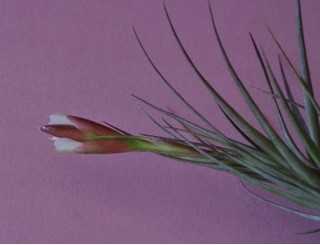
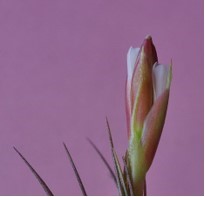
| v. vaginata Greg Aizlewood 06/21 |
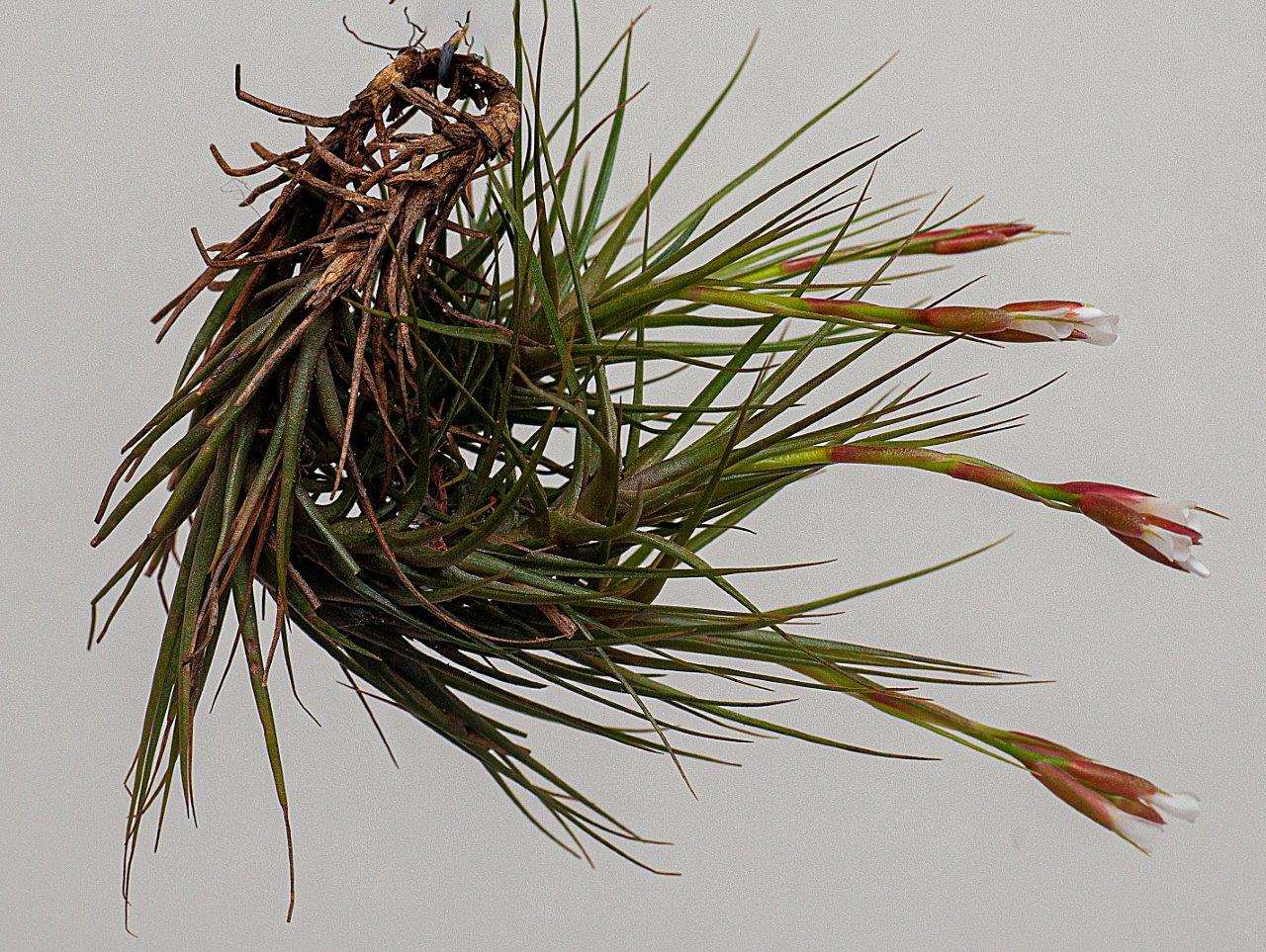
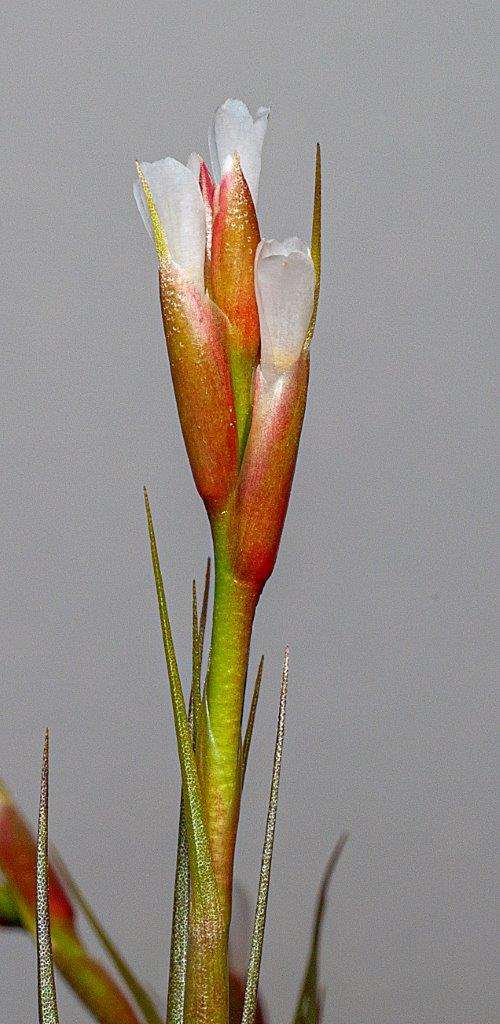
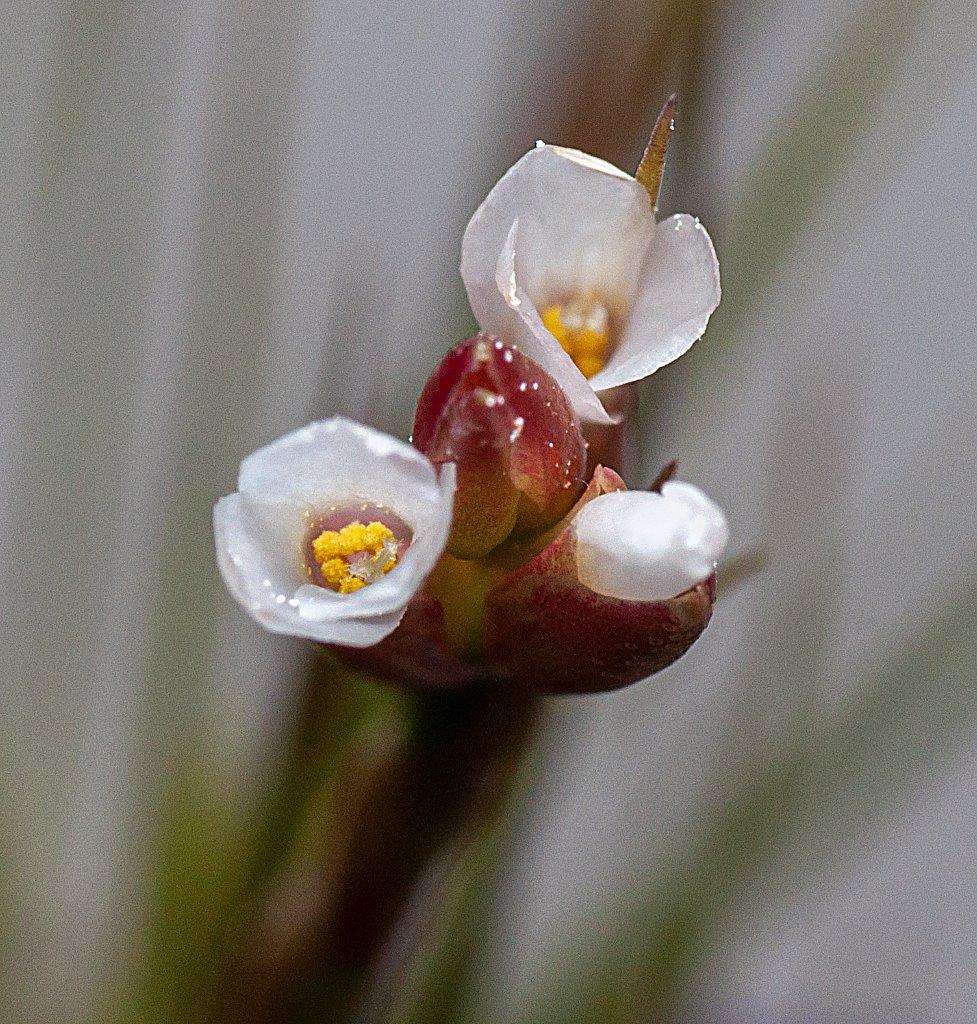

| v. vaginata Rob Bower 07/21 |
George Nieuwenhoven 05/15, araujei ? |
George Nieuwenhoven 05/15, See above ... "bought as T. tenuifolia caulescent form but looking at it closely and perusing the CD to me it looks more like T. araujei, input appreciated."
Derek Butcher ... "Yes, but. I also think of T. tenuifolia var saxicola. Some homework for you. Check it against the key below."
Eric Gouda ... "In fact, there are intermediate forms and in the end it will be difficult to keep T. araujei as a species to my opinion."
Tillandsia tenuifolia var. disticha
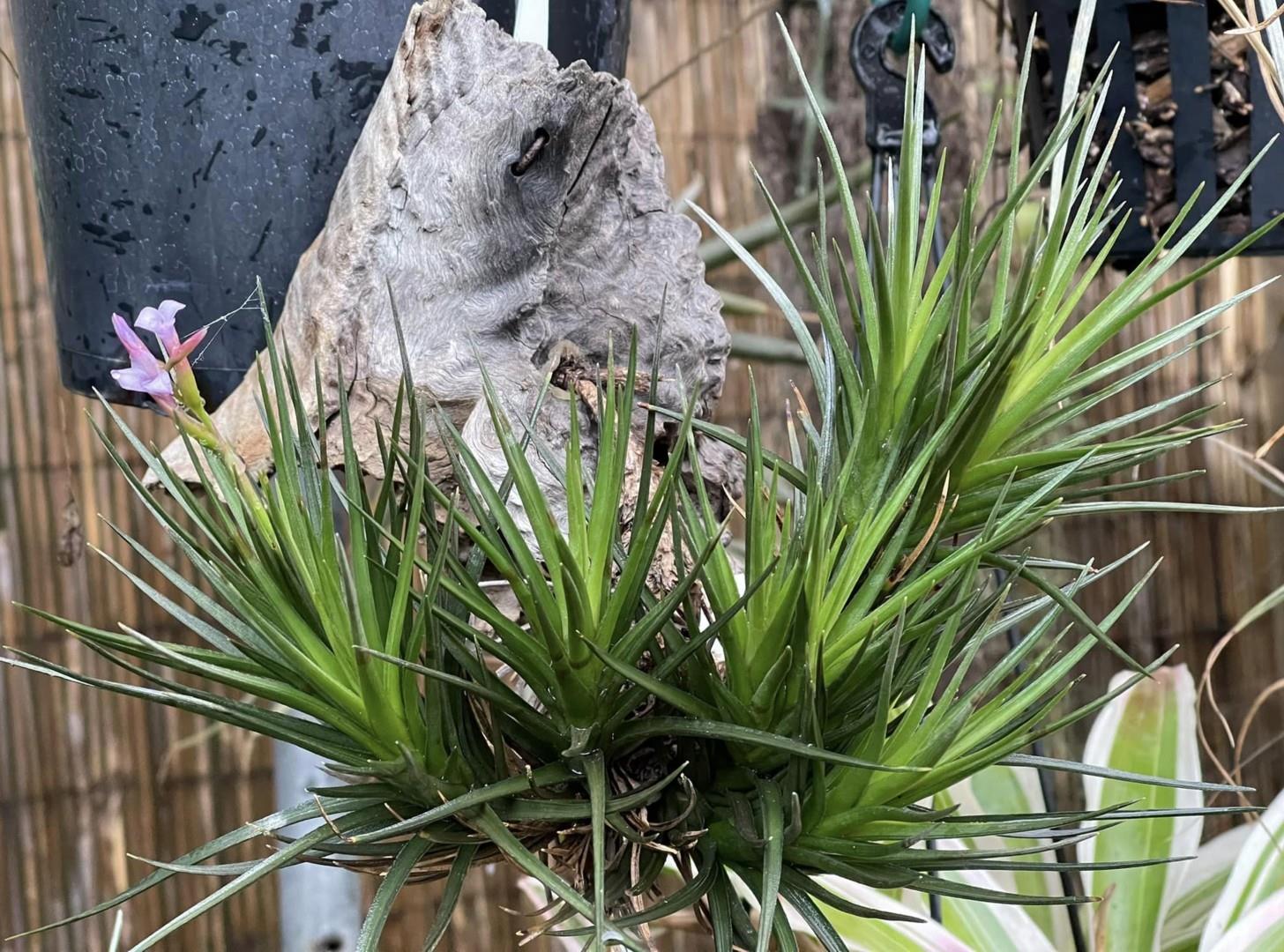
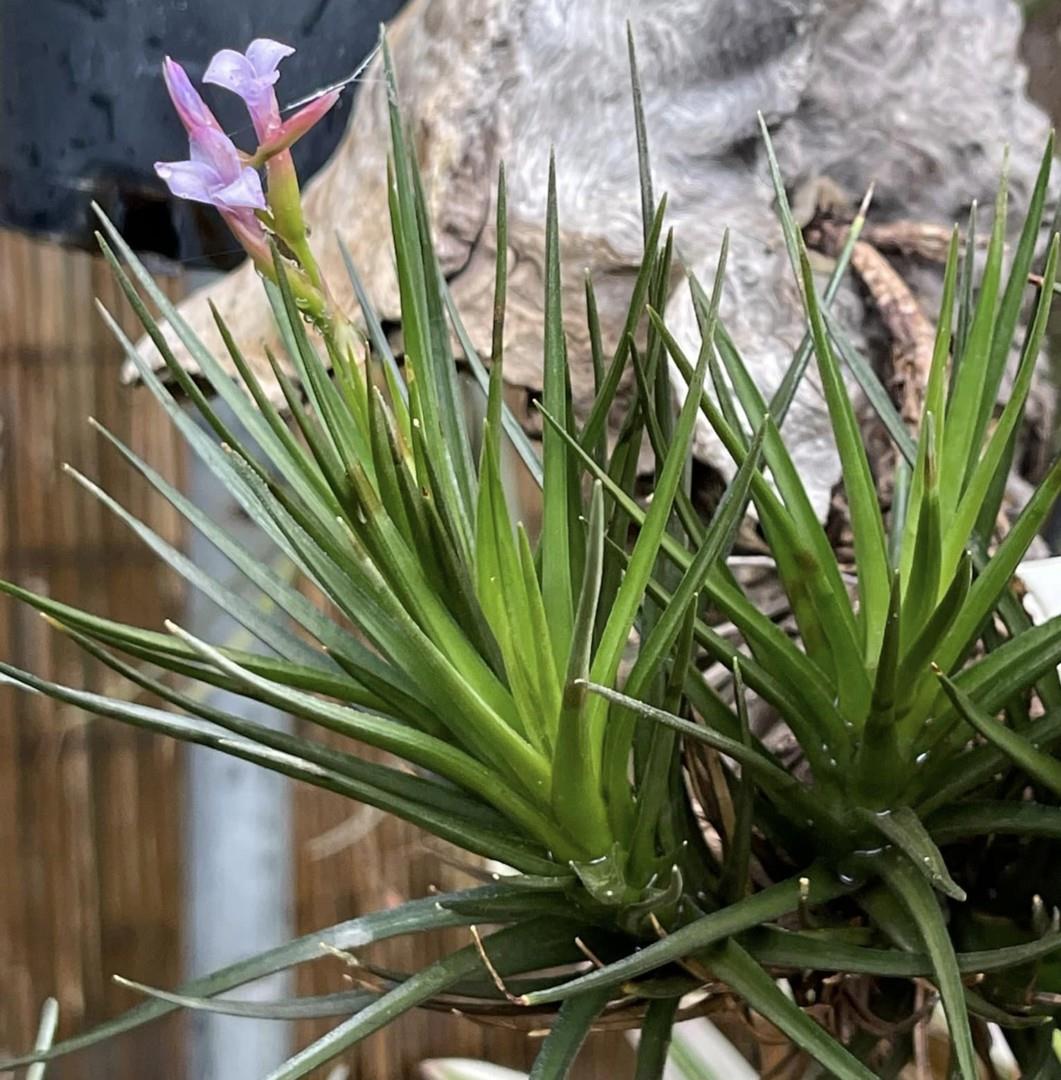
| var. disticha Ian Cook 02/24 |
Key to T. tenuifolia group by E Gouda Jan 2002
1.Spikes excluding petals 1.8-2.5 cm long. Petals 1.6 cm long. Filaments adnate to the petals -> T. pardoi
1. Spikes 2.5-5.5 cm long. Petals 2-3.3 cm long. Filaments free -> 2
2. Sheaths very broadly ovate. Sepals oblong -> T.cocoense
2. Sheaths deltoid. Sepals lanceolate -> 3
3. Leaves 7-15 cm long. Spikes subdensely flowered. Floral-bracts just exceeding the sepals -> T. tenuifolia
3. Leaves up to 7 cm long. Spikes laxly flowered. Floral-bracts much exceeding the sepals, to exceeding the sepals -> 4
4. Plant caulescent clustering and forming dense rooting, single plant to 9 cm tall 5-6 cm in diameter, not dense. Floral-bracts much exceeding the sepals (ca. ¼), the upper with very few scales near the apex. -> T. hofackeri
4. Plant long caulescent with enlarged apices which fix them to rocks, flowering 15-30 cm tall, dense. Floral-bracts exceeding the sepals, glabrous -> T. araujei
Chris Larson ... "I got a plant from P.Isley 15 years ago as T. tenuifolia var vaginata. Someone told me that it had to have white flowers to be var vaginata. So up until a year or 2 - I didn't use this name.
Recently I found a picture somewhere - somewhere I thought was reasonably taxonomically mindful of a blue/purple flower, with this name. The description doesn't mention white flowers. The drawings on Dereks disc appear to be a very similar plant to the drawing except with white flowers.
As the description doesn't mention petal colour - and it fits the drawing in other respects - I started to use this name for Isleys plant.
I haven't consulted the Encyclopedia, so I can't speak for what it says. Those more taxonomically inclined - what do you think ?
- From Derek's disc......
Tillandsia tenuifolia var vaginata (Wawra) L. B. Smith, Phytologia 8: 220. 1962.
Leaf-blades involute throughout and thus contrasting sharply with the sheaths, very slender, much shorter than the long branching stem, often spreading.
Flowers polystichous."

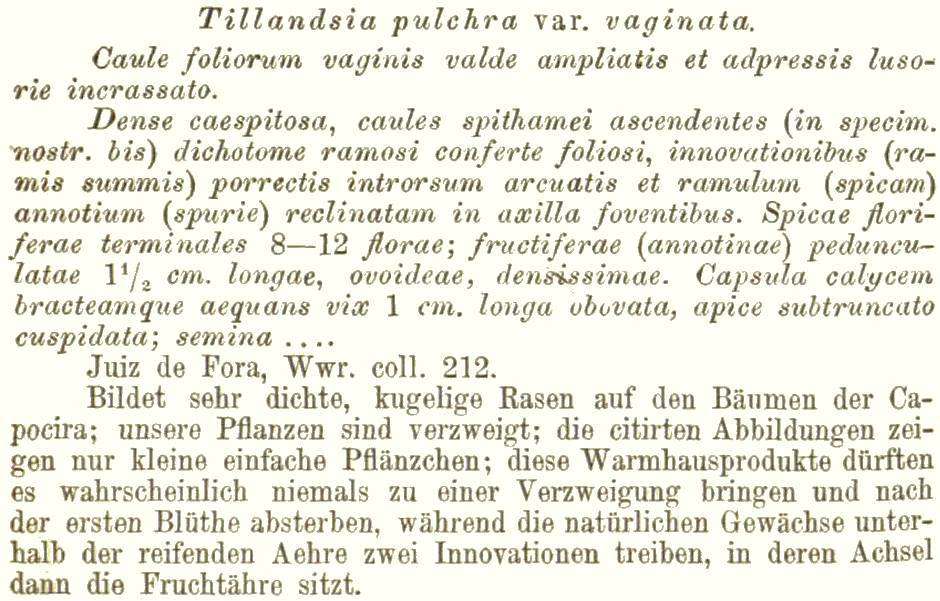


| Andrew Flower (see notes below) |
Vic Przetocki 09/22 saxicola, vaginata ? |
Andrew Flower ... "Hi Chris, I have one labelled "Tillandsia tenuifolia var. vaginata" that has blue flowers - got it in 1992 and it was imported from a US nursery by Len Trotman. In those days he was importing mainly from Tillandsia International.
The Encyclopaedia has white flowers on v. vaginata - and plant looks stronger and somewhat caulescent compared to my incorrectly named version (screen caps from encyclopaedia enclosed)."
Vic Przetocki ... "Have been growing this plant for many years as Till. tenuifolia, not sure if it is var. vaginata. Might be of interest."
Eric Gouda ... "To understand what T. (pulchella) tenuifolia var. vaginata Wawra should look like, I have added an original plate from Wawra (typified from plate and description) to the Encyclopedia, from which you can see that it does have white petals. To my opinion, it much resembles T. pardoi from the Caribbean, but is more caulescent and has colorful bracts and more flowers. I also added the protologue, but unfortunately not many measurements are given."
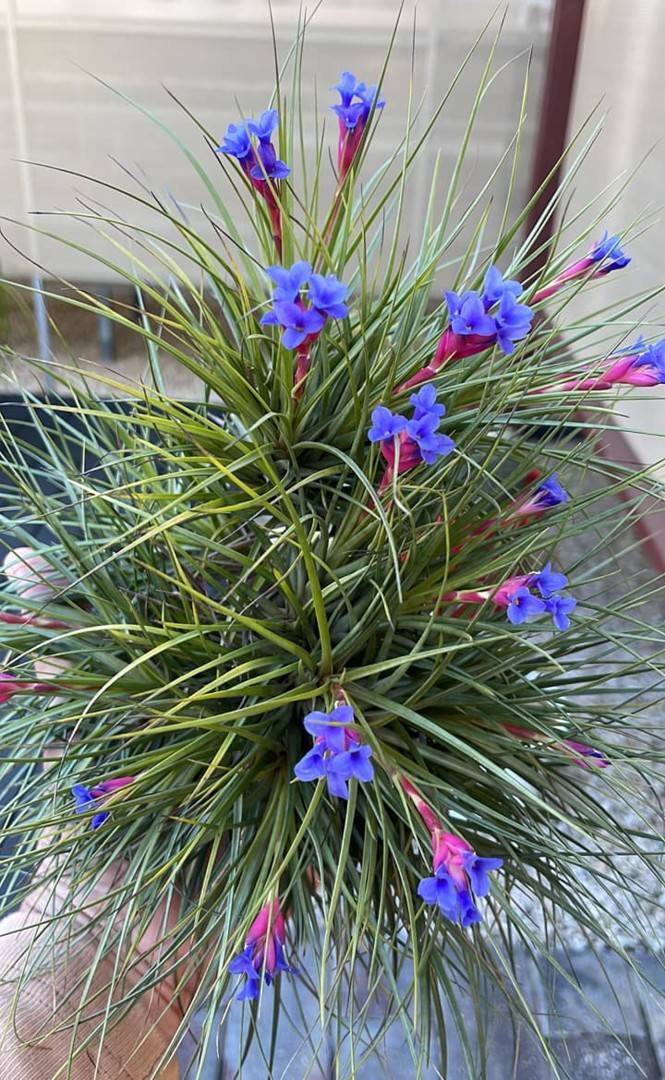

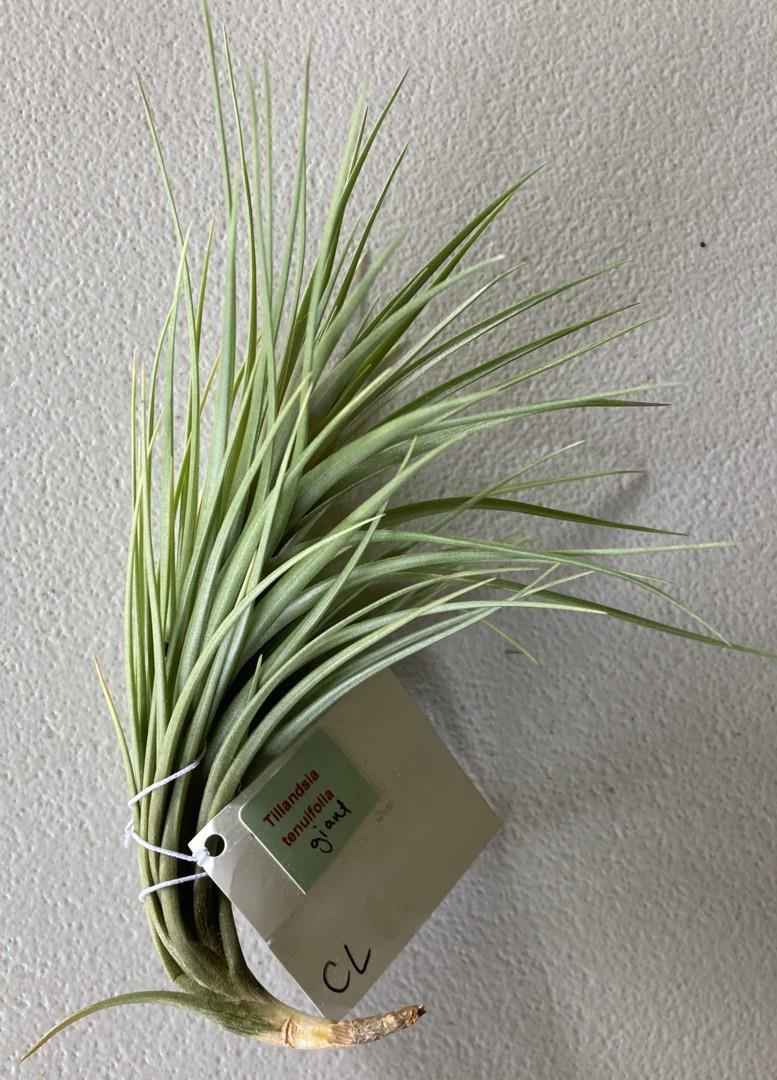
| Ray Clark 09/22 fine leafed |
Ian Hook 05/25 "Giant form" ex. CL |
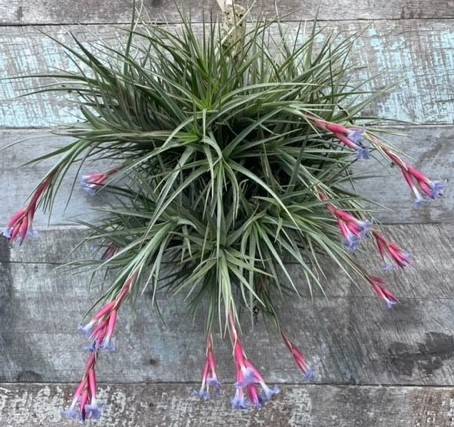
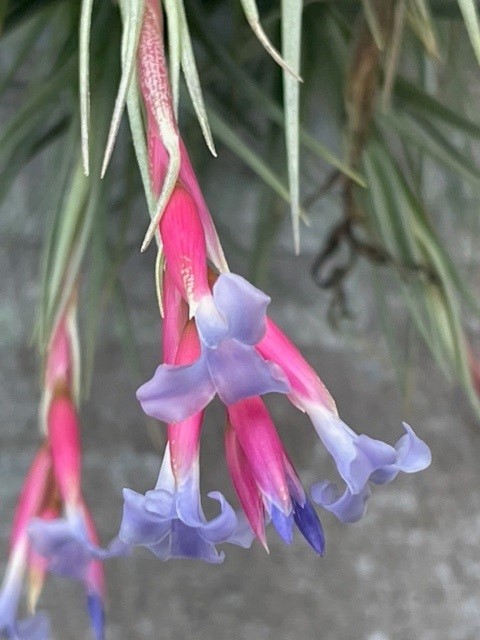
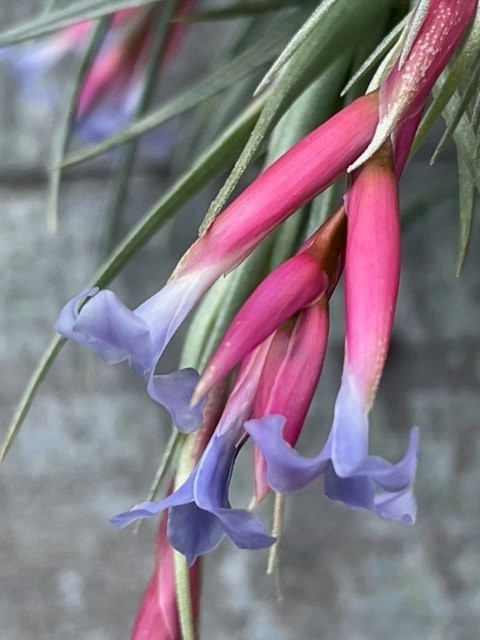
Bruce Dunstan 09/22 as tenuifolia 'Arturo' RFI
N.B. This hybrid has been registered as 'Gordon C'. RFI have no knowledge of the name 'Arturo' used in Australia. |
Tillandsia tenuifolia by Derek Butcher April 2017
Dare I say that this is a complicated species. In fact my file on this species now totals 21 pages of moves, countermoves and synonyms without a mention of DNA research.
The latest Die Bromelie 1: 2017 has an article by Eric Gouda on this species and introduces us to two varieties. Details follow.
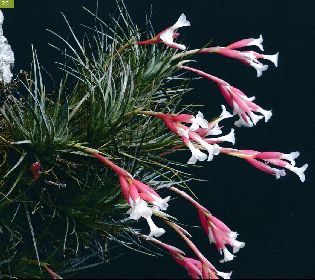
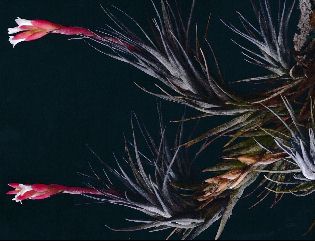
| tenuifolia v. glaucifolia |
tenuifolia v. nigrifolia |
Tillandsia tenuifolia var. glaucifolia Gouda, var. nov. Die Brom 1: 19-23. 2017
This variety differs from the type variety in having a less robust habit, with slender and less stiff leaves that are often bluish-green, drying brown (vs. bright yellowish-green, drying ochreous), petals often white or pale blue to dark blue (vs. always white).
Type. Bolivia, Prov. Santa Cruz, Samaipata. L. Dijkgraaf s.n., cultivated and flowered at the Botanic Gardens of the University of Utrecht with accession number 2001GR01050 (holotype L, isotype LPB).
Additional material studied: Brazil, Parana, Vila Velha (near Ponta Grossa), epiphyte in a canyon about 30 m deep. Feb. 1991. A. L. Copijn EG#40, cultivated at the Botanic Gardens of the University of Utrecht with accession number 1996GR01299 (L); Argentina, Prov. Misiones, near Androsito. 15-11-1994. A.L. Copijn EG#96., cultivated at the Botanic Gardens of the University of Utrecht with accession number
2003GR01723 (L).
Tillandsia tenuifolia var. nigrifolia Gouda, var. nov. Die Brom 1: 19-23. 2017
This variety differs from the type variety and other varieties in having leaves colouring deep purple-red to nearly black when exposed to direct sun light (vs. green and not colouring), having salmon coloured floral bracts, paler to yellowish toward the base (vs. uniformly bright pink, green or reddish floral bracts).
Type. Brazil, Estado Piaui, s.d., C. Pfister s. n., cultivated and flowered at the Botanic Gardens of the University of Utrecht with accession number 2008GR01388 (L).
You may already be growing these varieties, after all there are already 11 registered cultivars considered to be infraspecific to T. tenuifolia. Namely, ‘Amethyst’, ‘Bonsall Beauty’, ‘Emerald Forest’, Green Goddess’, ‘Hoya Gorda’, ‘Minima Tenuifolia’, ‘Pink Cascade’, ‘Silver Comb’, ‘Strobiliform’, ‘Toripe’, and ‘Yacuiba’. Some originated at Rainforest Flora and one called ‘Amethyst’ reminded me so much of var. nigrifolia but I leave any decision of changing names on labels or just noting labels up to you.
Tillandsia tenuifolia complex by Eric Gouda in Die Brom 1: 19-23. 2017
Tillandsia tenuifolia sensu lato is a very variable species and forms a complex of varieties and forms as well as several related species with a simple inflorescence with inflated floral bracts that are often brightly coloured, less often green. They have adaxial sepals that are highly connate and sharply carinate or, less often, less than half connate (Tillandsia montana Reitz). Some of the Tillandsia tenuifolia forms are difficult to distinguish from other species in the complex, for example from Tillandsia aeranthos L.B. Smith (1943) and Tillandsia araujei Mez (1894). The infraspecific taxa (varieties) are poorly circumscribed and need to be studied further. In this article some of the problems are cleared and new varieties are described and illustrated.
One of the problematic varieties, for example, is Tillandsia tenuifolia var. vaginata (Wawra) L. B. Smith (1962), in which all smaller plants with elongated stem and involute leaf blades (especially at the base) were included. All material from the Caribbean (Cuba, Dominican Republic, Haiti, Jamaica, Martinique, and Puerto Rico) and Northern Venezuela (Falcon, Distrito Federal, Aragua, Anzoategui, Monagas and Sucre), that formerly was included in Tillandsia tenuifolia var. vaginata, has been described as a species of its own, T. pardoi Gouda (2010). But this does not answer the question, what really is T. tenuifolia var. vaginata? There are forms that fit the description of T. tenuifolia var. vaginata but they need to be studied. As I did not check living material of T. tenuifolia var. vaginata from the type location, it is very hard to classify these other forms.
The distribution of Tillandsia tenuifolia sensu lato is very wide, it can be found from the Caribbean (if not to be re-identified as T. pardoi) and Venezuela to Argentina. The populations involved have adapted to many micro-habitats, with many of them being more or less isolated, resulting in many undescribed micro-species, varieties and forms. Some collections are mentioned for Mexico, but the only one I could verify, was wrongly identified and actually is Tillandsia chaetophylla Mez (1896). Some are mentioned from the USA (Mez 1935), but these refer to T. setacea Swartz (1797) and T. bartramii Elliott (1817) but not to T. tenuifolia Linnaeus (1753) which is treated under T. pulchella Hooker by Mez (1935).
It would not make sense to describe all forms and varieties as separate taxa, because we would end up with maybe 30 or more varieties and even then, it will be difficult or even impossible to distinguish them from each other. The type variety (Royen s.n.) is of unknown origin, probably grown in the Botanic Garden of Leiden, the Netherlands, and likely originated from Surinam (which was a Dutch colony at the time when Linnaeus described it in 1753). It resembles the other material known from Surinam in its stout form and color, which is quite typically drying to an ochreous coloration. It was described as Tillandsia pulchella var. surinamensis Miq. ex Mez (1894) and later realigned as Tillandsia tenuifolia var. surinamensis (Miq. ex Mez) Smith (1962). The holotype should be at Utrecht (U, sensu Srnith 1977), but is not found there. Carl Mez (1894) had seen material from the herbaria in Berlin (B), Bruxelles (BR), Schwacke, Vienna (W) and Warming. Type variety duplicates are known from Missouri (MO), Paris (P) and Stockholm (S). Obviously the variety Tillandsia tenuifolia var. surinamensis must be considered a synonym of the type variety (Gouda 1987).
In the identification key of the varieties of Tillandsia tenuifolia by Lyman B. Smith in Smith & Downs (1977), the type variety and T. tenuifolia var. surinamensis are distinguished from each other by an inflorescence shorter than the scarcely (if at all) secund slender leaves in the type variety and the inflorescence exceeding the stout and usually secund leaves in the latter one. The length of the peduncle in the T. tenuifolia complex is quite variable and not a good key character to differentiate the material from the Guianas and the Amazon area (North-Brazil) from the material from the Andean countries. There are other forms that have strongly secund leaves, but smaller and longer leaves compared to the robust leaves of T. tenuifolia from Surinam.
The plants from the Andean countries are obviously different from those from the Guianas and the Amazonian basin and deserve to be recognized as separate variety.
There are a few more very distinctive varieties that deserve to be recognized, too, but more research has to be done.
Tillandsia tenuifolia var. glaucifolia Gouda, var. nov. Die Brom 1: 19-23. 2017
This variety differs from the type variety in having a less robust habit, with slender and less stiff leaves that are often bluish-green, drying brown (vs. bright yellowish-green, drying ochreous), petals often white or pale blue to dark blue (vs. always white).
Type. Bolivia, Prov. Santa Cruz, Samaipata. L. Dijkgraaf s.n., cultivated and flowered at the Botanic Gardens of the University of Utrecht with accession number 2001GR01050 (holotype L, isotype LPB).
Additional material studied: Brazil, Parana, Vila Velha (near Ponta Grossa), epiphyte in a canyon about 30 m deep. Feb. 1991. A. L. Copijn EG#40, cultivated at the Botanic Gardens of the University of Utrecht with accession number 1996GR01299 (L); Argentina, Prov. Misiones, near Androsito. 15-11-1994. A.L. Copijn EG#96., cultivated at the Botanic Gardens of the University of Utrecht with accession number 2003GR01723 (L).
Tillandsia tenuifolia var. nigrifolia Gouda, var. nov. Die Brom 1: 19-23. 2017
This variety differs from the type variety and other varieties in having leaves colouring deep purple-red to nearly black when exposed to direct sun light (vs. green and not colouring), having salmon coloured floral bracts, paler to yellowish toward the base (vs. uniformly bright pink, green or reddish floral bracts).
Type. Brazil, Estado Piaui, s.d., C. Pfister s. n., cultivated and flowered at the Botanic Gardens of the University of Utrecht with accession number 2008GR01388 (L).
We are growing two collections both originating from the Botanical Garden of the University of Heidelberg, passed to us in 2008 by the late Jurgen Lautner, Botanical Garden of the Georg-August-University in Gottingen: the type specimen with reference "Pfister *88 (Heidelberg 11/1988)", and "Heidelberg 86 (9/1986)" with only Brazil as origin. It is not really clear to me whether Pfister was the collector or only passed the material to Heidelberg. Both collections are much alike and may be from the same source. No data are available about the origin of the specimen from Heidelberg without an accession number.
Tillandsia tenuifolia Linnaeus, Sp. Pl 286. 1753; Syst. Nat. ed. 10.974.1759.
For what its worth, most T. tenuifolia from northern South America have white petals; those from southern South America are blue or white. This is based on notes on herb. sheets as well as planted cult. at MSBG.
HEL May 2010.
Desc from S&D p828-33
Plant very variable, more or less caulescent with stem to 25 cm long, often branching and associated in great mats.
Leaves densely polystichous along the stem, 5-10 cm long, densely and minutely appressed-lepidote throughout;
Sheaths small and inconspicuous, barely distinct from the blades;
Blades narrowly triangular, subulate-attenuate, channeled above, 2-7 mm wide.
Scape erect or ascending, slender, short, largely concealed by the leaves;
Scape-bracts erect, imbricate, elliptic, caudate, membranaceous, rose.
Inflores¬cence about equaling the leaves, simple, polystichous-flowered, ovoid, densely 4-10-flowered.
Floral bracts like the scape-bracts but suborbicular and less caudate, much exceeding the sepals, punctulate-lepidote, prominently nerved;
Flowers erect.
Sepals lanceolate, acute, glabrous, 10 mm long, membranaceous, carinate and much connate posteriorly;
Petals blue, white, or rose,( Never seen any with rose petals -Butcher) 20 mm long, the claw linear, the blade oblong, broadly obtuse;
Stamens emerging from the throat of the corolla, shorter than the style, filaments transversely plicate.
Capsule cylindric, 15 mm long.
Key to the Varieties of Tillandsia tenuifolia by Butcher
1. Leaf-blades flat near the base, merging gradually into the sheaths, usually equaling or exceeding the simple or few-branched stem.
2. Plant not distinctly dorsi-ventral; leaves not completely secund. diverging from one another.
3. Inflorescence shorter than the slender leaves; leaves scarcely or not at all secund.
4. Flowers polystichous. >> var tenuifolia.
4. Flowers polystichous, scape and inflorescence much smaller >> var. dungsiana.
4. Flowers distichous. >> var disticha.
3. Inflorescence exceeding the stout usually secund leaves. >> var surinamensis. (Now var tenuifolia)
3. Inflorescence exceeding the light green not secund leaves >> var strobiliformis. ( Now ‘Strobiliform’)
2. Plant distinctly dorsi-ventral; leaves very densely ascending-secund with the blades closely approximate. >> var saxicola.
1. Leaf-blades involute throughout and thus contrasting sharply with the sheaths, very slender, much shorter than the long branching stem, often spreading. >> var vaginata.
Tillandsia tenuifolia var tenuifolia
Tillandsia foliis lineari-subulatis integerrimis imbricatis, caule oblongo, spica simplici laxa Royen, Fl. Leyden Prodr. 25. 1740. Type. Without locality, Royen s n (L). see below under Phytologia 8: 219. 1962.
Tillandsia pulchella Hooker, Exot. Fl. 2: pl. 154. 1825; with plate. Type. Without exact locality, Trinidad, DeSchach s n (K).
Tillandsia pulchra Hooker, Exot. Fl. 2: pl. 154. 1825; with text.
Tillandsia subulata Vellozo, Fl. Flum. 133. 1825; Icon. 3: pl. 127. 1831. Type. Vicinity of Rio de Janeiro, Brazil, Vellozo s n (lost if any specimen was ever made).
Anoplophytum pulchellum (Hooker) Beer, Bromel. 41.1857.
Diaphoranthema subulata (Vellozo) Beer, Bromel. 155.1857.
Tillandsia stricta var. caulescens Baker, Jour. Bot. London 26: 15. 1888. Based on Tillandsia subulata Vellozo.
Tillandsia astragaloides Mez in Martius, FI. Bras. 3(3): 601. 1864. Type. San Pedro, Misiones, Argentina, Niederlein 1211 (B, F photo 11479).
Tillandsia pulchella var rosea Mez in Martius, Fl. Bras. 3(3): 603. 1894; in part, not as to basionym.
Tillandsia pseudostricta Chodat & Vischer, Bull. Soc. Bot. Geneve 11.8: 263, figs. 122, 123. 1916. Type. Based on description and illustration since no specimens cited.see below for description.
? Tillandsia pernambucensis E. Pereira, Bradea I: 77, pl. 1. 1971. Type. Serra Itaquaritinga, Pernambuco, Brazil, E. Pereira 10467 (HB), 16 May 1966.See below for description
Plant not distinctly dorsi-ventral.
Leaves scarcely if at all secund, diverging from one another;
Blades flat near the base, merging gradually into the sheaths, usually equaling or exceeding the simple or few-branched stem.
Inflorescence exceeded by the leaves.
Flowers polystichous.
Much West Indian material intermediate between the typical variety and var. vaginata.
Type. Without locality, Royen s n (L).
DISTRIBUTION. Epiphytic in forest, 350-2500 m alt, West Indies to Bolivia and Argentina. CUBA. Las Villas: Buenos Aires, Sierra de Trinidad, 10 Apr l930, Jack 7930 (GH, US); 16 Mar 1932, 8589 (US); Topes de Collantes, 8 Apr 1940, Acuna 11118 (F, SV, US). Oriente: Without exact locality,Wright 685 (GH, US). JAMAICA. St. Andrew: Westphalia, 28 June 1952, Proctor 6855 (IJ, US). HAITI. Fourcy, Massif de la Selle, 30 Jul 1924, Ekman H-1198 (S, US); Caille la Croix, St. Michel, 12 Dec 1925, Leonard 8010 (US); Marmelade, Nord, 21 Dec 1925, Leonard 8394 (US); La Toison, Massif de Matheux, l3 Mar 1926, Ekman H-5703 (S); Mole St. Nicolas, 16 Feb 1929, Leonard 13304 (US); Jean Rabel, 2 Mar 1929, Leonard 13654 (US). REPUBLICA DOMINICANA. Barahona: Polo to Los Arroyos, 28 Feb 1969, Liogier 14337 (NY, US). Puerto Plata: Lomas de Jagua, 14 Mar 1930, Ekman H-14411 (S). Santiago: El Buzo, 14 Jan 1945, Jimenez 305 (US); Guazumal: 10 Sep 1950, Jimenez 2104 (US). La Vega: Constanza, Dec 1947, Allard 17640 (US); 17769 (US); Jan 1956, Jimenez 3181 (US). PUERTO RICO. Ciales, 5 Sep 1943, Sargent 3073 (US); Mount Montoso, Maricao, 28 Jan 1955, Winters s n (US). WINDWARD ISLANDS. Martinique: without exact locality, Belanger 1197 (P). VENEZUELA. Nueva Esparta: La Soledad, Dec 1951, Gines 2835 (US). Sucre: Carapa, 1925, Tate 345 (US); Peninsula de Paria: Cristobal Colon, Pittendrigh 1069 (US); Mundo Nuevo, Cerro de Humo, 7 Aug 1966, Steyermark & Rabe 96114 (US, VEN). Monagas: Caripe, 17 Apr 1945, Steyermark 62144 (GH, US). Anzoategui: Cerro-San Jose to Cerro Peonia, 20 Mar 1945, Steyermark 61565 (GH, US). Miranda: Los Teques, Apr 1931, Tamayo 12 (VEN), Distrito Federal Caracas, 24 Dec 1920, Bailey 462 (BH); 22 Jan 1922, Pittier 10093 (US); Naiguata, Nov 1963, 92029 (US, VEN); Portachuelo to Penita, 3l Jul 1966, Steyermark & Rabe 96018 (US, VEN). Aragua: Maracay, 1934, Vogl 1077 (M); Rancho Grande, 24 Oct 1951, Foster 2781 (US). Yaracuy: San Felipe, 10 Feb 1953, Trujillo 1639 (VEN). Falcon: Sierra de San Luis, Jul 1967, Steyermark 99074 (US, VEN); 99282 (US, VEN). Bolivar: Hato de Nuria, Jan 1961, Steyermark 88615 (NY); 88661 (NY, US, VEN). GUYANA. Essequibo: Bartika, 28 Aug 1935, Potter 5329 (GH). FRENCH GUIANA. St. Jean, 16 May 1914, Beioist 1232 (P). PERU. Puno, Sandia: Asalaya,4 Aug 1957, Vargas 11815 (US); Sandia, 9 Sep 1963, Vargas 14816 (US); 13 May 1966, Ferreyra 16643 (US, USM). BOLIVIA. La Paz, Larecaja: Sorata, 1858, Mandon I184 (S); Nov 1892, Bang 162B e p (G, GH, US); Nor Yungas: Polo-polo, Coroico, 1912, Buchtien 3672 (US); Inquisivi: Quimes, 15 Jul 1921, White 218 (NY). Cochabamba, Cercado: Tunari, 1892, Kuntze s n (NY). Santa Cruz, Valle Grande: Samaipata, Cardenas 3521(GH); Nov 1950, 4604 (US). Chuquisaca, Charcas: Santiago, 8 Dec 1958, Nelson 58-455 (US). BRAZIL. Para: Belem, 16 Nov 1942, Archer 7833 (IAN). Ceara: Without exact locality, Allemao e Cysneiros 1526 e p (R). Pernambuco: Sao Bento, Tapera, 12 Mar 1921, Pickel 137 (SP). Bahia: Maracas,19 Oct 1948, Foster 2464 (US). Espirito Santo: Bananal, Oct 1924, Vianna Freire 50 (R); Goitacazes, Rio Doce, 4 Apr 1934, J. G. Kuhlmann 138 (RB). Minas Gerais: Vicosa, 26 Dec 1958, Irwin 2316 (TEX, US); without exact locality, 11 Sep 1861, Regnell I-282-C e p (US). Distrito Federal: Brasilia, 20 Jun 1961, Heringer 8437/631 (BRAS, US). Mato Grosso: Cascata do Angelim, Serrado Itapirapuan, 26 Apr 1894, Lindman A-3523 (S); Guaira, Aug 1937, Cullen s n (RB). Rio de Janeiro: Petropolis, 9 May 1876, Glaziou 8025 (P); Boa Vista, Rio Paraiba, 29 Jul 1881, Neto, Glaziou & Schwacke s n (R); Serra dos Orgaos, s d, Schreiner s n (R); Teresopolis, May 1917 , Sampaio 2538 (R); Mar 1918, Frazao s n (RB); Nov 1956, Abendroth 11 (US); 15 (US). Guanabara: Rio de Janeiro, Gardner 695 (G, K); Copacabana, Glaziou 2730 (P); Serra da Carioca , 22 Apr 1951, Pabst 10081 (HB). Sao Paulo: Santos, 20 Feb l875, Mosen 1252 e p (S); Sao Paulo, Mar 1894, Edwall in Com. G. & G. de S. P. 2553 (SP); Vila Ema, Dec 1914, Brade 7582 (R); Campinas, May 1918, Campos Novaes 1201 (SP); Campos do Jordao, 15 Sep 1923, Hoehne s n, (GH, SP); Sep 1945, Eugenio 3605 (GH); Serra Negra, 6 Jun 1927, Hoehne s n (SP); Monte Alegre, Amparo, 26 Aug 1943, Kuhlmann & Kuhn 358 (SP); Rio Camanducaia, Monte Alegre do Sul, 26 Jul 1949, M. Kuhlmann 1885 (SP). Parana: Vila Velha, Ponta Grossa, 27 Nov 1908, Dusen 7235 (S); 20 Sep 1914, 15525 (S); 3 Nov l928, Hoehne s n (SP); 29 Aug 1939, M. Kuhlmann s n (SP); 5 Sep 1966, Moreira Filho & Moreira -388 (US); Tibagi, 9 Aug 1934, Reiss 83 (GH, US); Vossoroca, Paranagua, l5 Aug 1951, Hatschbach 2483 (MBM, US); Linha Espcranca to Prudentopolis, Sep l95l, Frenzel 650 (HBR.); Capao da Imbuia to Curitiba, 29 Aug 1964, Saito 34 (IDPN, US); Carambei, Castro, 3 Oct l964, Hatschbach 11672 (MFM,US); Medianeira, 14Apr 1965,
Hatschhach 12571(MBM, US); Campina Grande do Sul, 17 Aug 1966, Hatschbach 14614 (MBM, US); Capao Anfiteatro, Ponta Grossa, 5 Scp 1966, Hatschbach & Guimaraes 14646 (MBM, US). Santa Catarina: Sombrio, 27 Jul 1944, Reitz C-644 (GH); Fachinal, Biguacu, Reitz 4101 e p (HBR); Itapiranga, Jan 1952, Reitz 4284 (HBR); l9 Mar 1952, 4606 (HBR); Dionisio Cerqueira, 14 Mar 1952, Reitz 4595 (HBR); Itajai, l8 Mar 1954, Reitz & Klein 1761 (HBR, US); Campo Alegre, l7 Oct 1957, Reitz & Klein, 5187 (HBR, US); Campo Ere, 28 Dec 1956, Smith, Reitz & Caldato 9534-A (US); Rio do Sul, 13 Mar 1959, Reitz & Klein 8576 (HBR, US); Jacinto Machado, 4 Sep 1959, Reitz & Klein 9035 (HBR, US); Serra da Boa Vista, Sao Jose, 8 Sep 1960, Reitz & Klein 9924 (HBR, US); Curitibanos, 12 Sep 1963, Reitz & Klein, 16145 (HBR, US); Irani, 13 Oct 1964, L. B. Smith & Reitz 12471 (HBR, R, US); Chapeco, 10 Nov 1964, L. B. Smith & Klein 13099 (HBR, US). Rio Grande do Sul: Santo Angelo, 26 Jan 1893, Lindman A-1037 (S); Theewald, 17 Mar 1906, Bornmueller 709 (GH); Sao Leopoldo, Mar 1941, Eugenio 120 (R); 212 (SP); 2511 (GH); 1941, 2514 (GH, HBR); Tainhas to Taimbezinho, 7 Feb l966, Sick B-859 (HB, US). PARAGUAY. Tebicuary, 1967, Schinini 46803 (HB, US). ARGENTINA (including many intermediates with var. surinamensis). Jujuy: 16 Oct 1963, Fabris 4475 (LP); Capital, 26 Sep 1938, Eyerdam & Beetle 22239 (GH, UC); 23 Oct 1948, Velarde s n (US). Salta: Alemania, Gurachipas, l2 Dec 1929, Venturi 9976 (US); Urundel, 25 Oct 1948, L. B. Smith 4581 (US). Tucuman: Rio de Siambon, 30 Aug 1913, Castillon 2997 (GH, LIL,); Chanar Pozo, Leales, 27
Oct 19l9, Venturi 676 (US). Misiones: Puerto Iguazu to Puerto Esperanza, Mar 1907, Spegazzini s n (BA).
Tillandsia tenuifolia var disticha (L. B. Smith) L. B. Smith, Phytologia 8: 220. 1962.
Tillandsia pulchella var disticha L. B. Smith, Arq. Bot. S. Paulo II. I: 114, pl. 117. 1943.
Plant not dorsi-ventral.
Leaves scarcely if at all secund, diverging from one another;
Blades flat near base, merging gradually into the sheaths.
Inflorescence shorter than the slender leaves.
Flowers distichous.
Type. Wilkes Expedition s n (holotype GH), Rio de Janeiro, Guanabara, Brazil. DISTRIBUTION. Epiphytic in forest, to 1800 m alt, central eastern Brazil.
BRAZIL. Sao Paulo, Barreiro: Serra da Bocaina, 3 Mar 1953, Segadas-Vianna et al no. Serra-I-284 (R, US)
Tillandsia tenuifolia var surinamensis (Mez) L. B. Smith, Phytologia 8: 220. 1962. Treated as a synonym of T. tenuifolia var tenuifolia by Gouda in Die Brom 3: 137. 2010 and Flora of the Guianas 1987.
Tillandsia bicolor sensu Grisebach, PI. Lorentz. Gott. Abh. 19: 272. 1874; non Brongniart, 1829. Based on Lorentz 510 (CORD), Siambon, Sierra de Tucuman, Tucuman, Argentina, Mar 1872.
Tillandsia autumnalis F. Muller, Gartenflora 42: 737. 1893. Type. Blumenau, Santa Catarina, Brazil, F. Muller s n (K), Mar 1892.
Tillandsia pulchella var surinamensis Mez in Martius, FI. Bras. 3(3): 603. 1894.
Tillandsia surinamensis Miquel ex Mez in Martius, Fl. Bras. 3(3): 603. 1894: nomen in synon.
Tillandsia firmula Mez in Martius, Fl. Bras. 3(3): 603. 1894. Type. Corcovado, Rio de Janeiro, Guanabara, Brazil, Glaziou 3127 (P, GH photo), 16 Mar 1869.
Tillandsia pulchella forma surinamensis Mez in Luetzelburg, Estudo Bot. Nordeste 3: 104. 1923; nomen.
? Tillandsia appariciana E. Pereira, Rodriguesia 38: 114, pl. 3. 1971. Type. Serra Grande, Minas Gerais, Brazil, A. P. Duarte s n (RB 137233), cult. 14 Ju1 1968. Or is it T. araujei sensu Till
? Tillandsia neglecta E. Pereira, Bradea 1: 78, pl. 2. 1971. Type. Cabo Frio, Rio de Janeiro, Brazil, D. Sucre s n (HB 50230), cult. 24 May 1967.NOW TREATED AS SPECIES IN ITS OWN RIGHT
Plant not distinctly dorsi-ventral.
Leaves usually secund but divergent from one another;
Blades flat near base, merging gradually into the sheaths.
Inflorescence exceeding the leaves.
Flowers polystichous.
Type. Hostmann 592-A (holotype U), without exact locality, Suriname.
DISTRIBUTION. Epiphytic in mostly low dry forest, from near sea level to 2000 m alt, Guyana to Argentina.
GUYANA. Berbice: Canje River, Jenman 1845 (K); Corentyn River, im Thurn s n (K). SURINAME. Para District, Splitgerber 670 (L); Geyersvlijt, Kegel 801 (GOET); Kabalebo River, Pulle 460 (U); upper Nickerie River, Gongrijp & Stahel 1013 (U); Goddodam, Suriname River, Tresling 266 (U); Perica River, Commewijne District, Lindeman 5435 (U); Kaboerie Creek, Corantijne River, B. W. 2106 (U); without exact locality, Kappler 184 (S); Wilhelmina Gebergte, Aug 1963, Irwin et al 55176 (NY); 55195 (NY). FRENCH GUIANA. Mana, 1856, Rouquie s n (P). BOLIVIA. Tarija: Motovi, 27 Sep 1927 ,Troll 251 (M). Chuquisaca: Bartolo, Monteagudo to Sucre, 24 Sep 1949, Brooke 5684 (NY). BRAZIL. Ceara: Aratuba, Cutler 8177 (US). Paraiba: Pocinhas, Oct 1920, Luetzelburg 15509 (M); San Antonio, Campina Grande, 5 Oct 1927, Ginzberger 1495 (W). Pernambuco: Tapera, Jul 1928, Pickel 1699 (lPA); Serra Negra, Inaja, 22 Nov 1954, A. Lima 54-1950 (US); Brejo da Madre de Deus, Pedra do Cachorro, 7 Apr 1955, A. Lima s n (US). Bente: Agua Preta, 1919, Foster 109 (GH, R). Espirito Santo: Santa Teresa, 28 Jul 1939, Foster 306 (GH). Minas Gerais: Caldas, 30 Aug 1875, Mosen 3990 (S); Caraga, 1885,Vainio 33939 (TUR); Jun 1885, Gounelle s n (P); Paraopeba, 30 Oct 1959, Heringer 7256 e p (HB); Felixlandia, 30 Oct 1959, Heringer 7256 e p (HB); without exact locality, St Hilaire G-61 (P). Distrito Federal: Brasilia, 20 Jun 1961, Heringer 8437 (NY). Goias: Veadeiros, 19 Oct 1965, Irwin et al 9301 (NY). Rio de Janeiro: without exact locality, Glaziou 16455 (C). Guanabara: Serra da Carioca, 26 Mar 1929, L. B. Smith 2150 (GH). Sao Paulo: Sao Paulo, 15 Feb 1827, Burchell 4222 (K); Iguape, 28 Apr 1918, Hoehne s n (SP); Jaragui, Brade 7203 (SP); Alto da Serra, 4 May 1921, A. Gehrt s n (SP); Cidade Jardim, Sao Paulo, 3 Feb 1929, L. B. Smith & Kuhlmann 1812 (GH); Ubatuba, 8 Mar 1940, Viegas, Franco & Lima s n (IAC); Santo Amaro, 25 Mar 1942, Krieger 174(SP); Piedade, Mee 30 (SP); Bertioga, 5 Feb 1968, L. B. Smith & McWilliams 15392 (MICH, R, US); Campos do Jordio, 1961, Abendroth s n (US); without exact locality, Sellow 5877 (B, GH photo); P-88 (P). Parana: Alto da Serra, 25 Aug 1939, Foster 403 (GH, R). Santa Catarina: Blumenau, Apr 1888, Ule 661 (HBG); Peroba, Sombrio, Reitz C-472 (HBR); 3705-8 (HBR); Espigao de Barro, Praia Grande, 26 May 1944, Reitz C-605 (GH); Sombrio, l5 Mar 1951, Reitz 1763 (HBR, US); Sao Francisco do Sul, 6 May 1951, Reitz 4012 (HBR); Vargem de Cedro, Sao Martinho, 2 Jan 1952, Reitz 4530 (HBR); Corupa, 25 Apr 1951, Seidel 15 (HBR); Piloes, Palhoca, 14 Mar 1952, L. B. Smith 6218 (R, US); Ibirama, 1 Mar 1954, Reitz & Klein 1571 (HBR, US); Campo Alegre, 9 Nov 1956, L. B. Smith & Klein 7510 (HBR,US); Papanduva, 20 Oct 196l, E. Pereira 6220 (RB); Pabst 6047 (RB); Campos Novos, 12 Sep 1963, Reitz & Klein 16157 (HBR, US). Rio Grande do Sul: Porto Alegre, Tweedie 523 (K); 52a (K); 525 (K); Sao Jeronimo, Schwacke s n (R); Canoas, Porto Alegre, 3 Oct 1892, Lindman A-353 (S); Palmares, Rambo s n (US); Sao Leopoldo, Eugenio 126 e p (NY); Mar 1942, 213 (SP); 1941, 2609 (GH); 2610 (GH); Est. Sao Salvador, 6 Sep 1946, Sehnem 2094 (LIL); Morro Sapucaia, 29 Jan 1948, Palacios & Cuezzo 429 (LIL); Campo Bonito, Torres, 26 Feb 1952, Reitz 4416 (HBR); Canela, 17 Oct 1964, Richter s n (HB); without exact locality, Sellow 4002 (B). PARAGUAY. Pirapo, 6 Aug 1893, Lindman s n (S); Cerro San Tomas, Paraguari, 27 Sep 1893, Lindman A-1925 (S); 7 Sep 1916, Osten & Rojas 8803 (MVM); Cerros de Acahy, Apr 1919, Rojas 255 (MVM); Jun 1919, 3538 (GH); San Bernardino, s d, Hassler 3286 e p (G); Colonia Independencia, Jul 1967, Schinini 2-SA (US). ARGENTINA. Jujuy: Santa Barbara, Sep 1901, Fries 419 (S); Sierra de Calilegua, Ledesma, 10 Oct 1927, Venturi 5360 (GH, US). Salta: San Andres, Oran, Sep 1873, Lorentz & Hieronymus 279 (US); Los Banos, Rosario de la Frontera, 16 Aug 1929, Venturi 9424 (US); Quebrada San Lorenzo, 23 Aug 1936, Cabrera 3803 (F, GH). Tucuman: Yerba Buena, Tafi, 30 Jun 1917, Schreiter 8 (GH, LIL, NY); 6 Aug 1917, s n (MVM); 17 Oct 1917, s n (MVM); 20 Sep 1920, Venturi 957 (GH, US); Tapia, Trancas, Oct 1920, Venturi 1395 (GH); Cadillal, 13 Aug 1922, Schreiter 2273 (MVM); 1 Oct 1932, 9086 (GH, LIL); Las Arcas, Tafi, 26 Feb 1927, Venturi 8670 (US); La Toma, Tafi, 10 Jun 1945, Merrero 686 (AA).
Tillandsia tenuifolia var saxicola (L. B. Smith) L. B. Smith, Phytologia 8: 220. 1962.
Tillandsia pulchella var saxicola L. B. Smith, Arq. Bot. S. Paulo II. I: 115, pl. 118.1943.
Plant distinctly dorsi-ventral.
Leaves very densely ascending-secund;
Blades closely approximate, flat near base, merging gradually into the sheaths.
Flowers polystichous.
Type. A. Gehrt s n (holotype GH, isotype SP), Pedra Grande, Sao Paulo, Brazil, 6 Sep 1939.
DISTRIBUTION. Saxicolous, ca 1000 m alt, central eastern Brazil.
BRAZIL. Guanabara: Morro do Archer, 13 May 1929, Brade 10410 (R). Sao Paulo: Serra de Itapetinga, Oct 1910, C. Duarte s n (GH, SP); Atibaia, l5 Aug 1929, Ostermeyer s n (SP); Pedra Grande, 7 Sep 1939, Foster 481 (GH).
Tillandsia tenuifolia var vaginata (Wawra) L. B. Smith, Phytologia 8: 220. 1962. Tillandsia triflora Vellozo, Fl. Flum. 134.1825; Icon. 3: pl. 134. 1831. Type. Based on description and illustration.
Diaphoranthema triflora (Vellozo) Beer, Bromel. 155. 1857.
Tillandsia pityphylla Martius ex Schultes filius in Roemer & Schultes, Syst. 7(2): 1208. 1830. Type. Without exact locality, Bahia, Brazil, Martius s n (M).
Tillandsia pulchra var vaginata Wawra, Osterr. Bot. Zeitschr. 30: 224. 1880.
Tillandsia dianthoidea Schott ex Wawra, Osterr. Bot. Zeitschr. 30: 224. 1880; nomen; non Rossi, 1825.
Anoplophytum amoenum E. Morren, Belg. Hortic. 33: 265, pl. 17. 1883. Type. Without exact locality, Brazil, Glaziou 96 in Morren Hortus s n (? LG n v), 1882. The species is adequately typified by the original description and illustration.
Anoplophytum brachypodium E. Morren ex Baker, Handb. Bromel. 196. 1889; nomen.
Tillandsia pulchella var pityphylla (Martius ex Schultes filius) Mez in Martius, FI. Bras. 3(3): 603. 1894.
Tillandsia pulchella var vaginata (Wawra) Castellanos, An. Mus. Nac. Hist. Nat. Buenos Aires 37: 505.1933.
Tillandsia amoena (E. Morren) Mez in Engler, Pflanzenreich IV. Fam. 32: 451. 1935; non Loddiges, 1818.
Tillandsia cyanescens Mez in Engler, Pflanzenreich IV. Fam. 32: 563. 1935. Based on Anoplophytum amoenum E. Morren.
Tillandsia brachypodia Mez in Engler, Pflanzenreich IV. Fam. 32: 564. 1935. Type. Without exact locality, Rio de Janeiro State, Brazil, Glaziou 16456 (K).
Tillandsia candida Leme Bradea Vol. IV, No. 50, 397, 404, 1987
Leaf-blades involute throughout and thus contrasting sharply with the sheaths, very slender, much shorter than the long branching stem, often spreading.
Flowers polystichous.
Type. Wawra 11 - 212 (W lost), Juiz de Fora, Minas Gerais, Brazil. In the absence of any specimen, the species is well typified by Wawra, It. Sax.-Cob. 173, pl. 24, fig. B. 1883.
DISTRIBUTION. Epiphytic in forest, to 900 m alt, West Indies to Brazil and Paraguay.
JAMAICA. St. Andrew: Blue Mountains, 25 Apr 1894, Harris in hb. Jam. 5138 (G, CH). WINDWARD ISLANDS. Martinique: without exact locality, Hahn 1409 (P). BRAZIL. (Mez reports as yet unverified Luetzelburg collections from the states of Piaui, Bahia, Goias, Paraiba and Rio Grande do Norte). Espirito Santo: Cachoeira de Itapemirim, 15 Aug 1940, Foster 924 (GH). Minas Gerais: Rio Sao Francisco, 1818, Pohl s n (BR); Caldas, Regnell I-282-D e p (S); 4 Dec 1862, III-1250 (S, US); 20 Dec 1873, Mosen 1734 (S); 25 Jan 1876, 4440 (S); Hoehne s n (SP); Serra de Caracol, 30 Dec 1873, Mosen 1735 (S); Sitio Barbacena, Dec 1905, Sampaio 342 (R); Sete Lagoas, 30 Nov 1940, Occhioni s n (RB); Coronel Pacheco, 20 May 1942, Heringer 1007 (SP); Contagem, Petim, 8 Feb 1945, Assis & Moreira inWilliams 8222 (GH, US); Paraopeba, 24 Mar 1957, Heringer s n (HB); Caxambu, Nov 1958, Pabst 4628 (HB). Rio de Janeiro: Soumidouro to Tamarate (Petropolis), 11 Nov 1825, Burchell 1105-56 (K); Nova Friburgo, Peters s n (W); 6 Jun 1881, Glaziou 13257 (GH, P); Rio Paraiba, Boa Vista, 28 Jul 1881, Glaziou s n (P); Maua, Feb 1901, Hemmendorff 464 (S); Teresopolis, May 1917, Bessa & Sampaio 252l (R); Sampaio 2521-A (R); 2652 (R); Barra de Sao Joao, Casimiro de Abreu, 1953, Segadas-Vianna no. restinga -I-276 (R, US). Guanabara: Sao Cristovio, 27 Mar 1885, Glaziou 13239 (P); Tijuca, Excelsior, 1 May 1939, B. Lutz 1442 (R); Jacarepagua, E. Pereira 101 (RB). Sao Paulo: Campinas, 5 Dec 1894, Campos Novaes s n (SP, US); Itu, 10 Nov 1897, Russel s n (SP); Ribeirio da Lagoa, Edwall in Exped. Rio Feio 180 (SP); Serra do Mar, Jul 1898, Edwall in Com. G. el G. de S. Paulo 4040 (GH, SP); Ipiranga, Jul 1909, Luederwaldt s n (GH, SP); Atibaia, Aug 1910, Duarte s n (GH, SP); Butanta, Sao Paulo, 26 Aug 1917, Hoehne s n (GH, SP); Bosque de Saude, Sao Paulo, 4 Aug 1923, Hoehne s n (SP); Iguape, 1918, Brade 7905 (R); Pirajussara, 17 Aug 1929, A. Gehrt s n (GH, SP); Ipero, 10 Nov 1936,W. Hoehne & Gehrt s n (SP); Una, 23 Aug 1939, Foster 387 (GH, R); Rio Tijuca, 1 Sep 1939, Foster 471 (GH); Campos do Jordao, Jan 1946, Eugenio 3851 (GH); Sao Joao da Boa Vista, 9 Dec 1964, Santos 5752 (R). Parana: Jaguariaiva, 22 Nov 1914, Dusen s n (S); Itaperucu, 18 Nov 1908, Dusen 7112 (S); Roca Nova, 14 Sep 1916, Dusen 10274 (S); Palmeiras, 27 Aug 1939, M. Kuhlmann s n (GH, SP); Serra Dourada, 6 Nov 1959, Braga & Lange 100 (lnst. Hist. Nat. Curitiba). PARAGUAY. Villa Rica, Balansa 3314 (P); 15 Feb l929, Jorgensen 3963 (BAF, US); Colonia Presidente Gonzalez, 8 Aug 1893, Lindman A-1851 (S); Trinidad, 8 Aug 1916, Rojas s n (MVM); Primavera, upper Rio Paraguay, 24 Oct 1957,Woolston 897 (US); Colonia Independencia, Guaira, 10 Oct 1967, Lourteig 1998 (P).
Tillandsia tenuifolia var dungsiana E Pereira Bradea 2 No. 25, 1977
Differs from var. saxicola
Leaves not at all secund
Scape much smaller
Inflorescence much smaller
Holotype HB 62.321
Habitat. Brazil, State of Rio de Janeiro, Leg. F. Dungs Nr. 5, 9/April/1976
Tillandsia tenuifolia var. strobiliformis Ehlers Die Bromelie 2/1996 p41-2 treated as a synonym of T. tenuifolia var tenuifolia by Gouda in Die Brom 3: 137. 2010
Plant very short caulescent, ca. 10cm high, 10cm diam.
Leaves as long as the stem, erect, not secund, light green, hard, the blade narrow triangular.
Inflorescence exceeding the leaf rosette, to 7cm long, 2cm diam, very thick pine-cone shaped, 15 – 25 polystichous flowers.
Type locality Brazil, Espirito Santo, near Domingos Martins, 800 – 1200m alt, leg. K&R Ehlers EB7851, July 1978, flowered in collection of Ehlers Oct 1992 (Holotype WU)
Habitat and range: Up to now scarcely known from the type location. The plant is growing in woodland together with T. kautskyi and a particularly beautiful small grey T. stricta.
Differs from TYPE in
Inflorescence exceeds leaves
Inflorescence dense cone-like and many flowered (up to 25 flowers)
Tillandsia candida Leme Bradea Vol. IV, No. 50, 397, 404, 1987
Treated by Till as a synonym of var. surinamensis but inflorescence is distichous! Treated by Luther (De Rebus I) as a synonym of var. vaginata but again the inflorescence is distichous. This plant seems to be between var. vaginata and var. disticha.
Plant epiphytic, caulescent, stem ca 4cm long, flowering to 8cm high.
Leaves 25-30, polystichous and sub-dense, green, both sides dense white lepidote.
Sheath triangular, ca 5mm long, 6mm wide near base, hyaline toward the base, strongly nerved, clasping and totally covering the stem.
Blade filiform, more or less terete near the base, towards the apex slenderly subulate, 40-65mm long, ca 1mm wide, sub-erect to spreading.
Scape erect, glabrous, green, slender, ca 30mm long, ca 1mm diam.
Scape bracts leaflike, ca 3, not at all hiding the whole of the scape, equalling the inflorescence.
Inflorescence simple, distichous, erect, ca 15mm long, as high as the leaves or exceeding them.
Rhachis lightly flexuous, clearly visible.
Floral bracts elliptic at the base, 5-8mm long, ca 5mm wide, green, sub-glabrous, equalling the length of the sepals, ecarinate, blade a slender filiform tail, ca 10-15mm long, dense white lepidote, sub-erect, more than twice as long as the flower.
Flowers 2 – 3, subsessile.
Sepals narrow lanceolate, acute tip and apiculate, ca 7mm long, ca 1.5mm wide, glabrous, lightly nerved, the posterior pair connate for 5mm and keeled, anterior sub-free and not keeled.
Petals sub-linear, 10mm long.
Stamens included, Filament complanate, widening towards the base and not plicate, ca 5mm long, Anthers ca 0.7mm long, oblong, on both sides obtuse, dorsifixed at the base. Ovary obovate-cylindric, ca 4mm long, ca 1.5mm diam, Style ca 4mm long, included
Type Bahia, Nova Itarana, ca 1000m alt. Leg Alvim Seidel 975. Flowered in cultivation in Aug. 1987.
Tillandsia pernambucensis E. Pereira, Bradea I: 77, pl. 1. 1971. Treated as a possible synonym of T. tenuifolia var tenuifolia in S&D
Plant epiphytic, caulescent, not at all dorsiventral, curved, with dense foliage above.
Leaves polystichous, secund, rigid leathery.
Sheath hyaline, 14mm long.
Blade from the base narrow triangular narrowing to a pungent filiform tip, 10cm long, both sides with inconspicuous appressed scales.
Inflorescence a simple spike, more than 10 flowered, strobiliform, totally white, shorter than the leaves.
Scape erect, 2-3cm long, totally covered by the scape bracts and hidden between the leaves.
Scape bracts ovate, glabrous, conspicuously nerved, 15-17mm long, 8mm wide, the tip acuminate, the point 8mm long, towards the base appressed scales.
Rhachis erect, completely hidden.
Floral bracts narrow ovate, becoming acute, concave, conspicuously nerved, 12mm long, glabrous, much exceeding the sepals and much adpressed.
Flowers erect, 15-20mm long, sessile, polystichous, much appressed.
Sepals lanceolate, glabrous, 10mm long, anterior free, the posterior pair a little connate.
Petals white, 15-18mm long, linear, becoming acute, erect at anthesis.
Stamens included, much shorter than the petals, barely reaching the height of the throat, Filament 7mm long, linear, the upper half plicate, free, acute insertion to the anther, Anthers yellow, basifixed, 1.5mm long, linear, tip acute, base obtuse, Ovary cylindric, 2mm long, the lower part fertile, the upper part sterile, Style 7-10mm long, erect, attenuate towards the tip, Placenta linear, the lower half affixed to the internal angle, Ovules many, cylindrical, base rounded, the tip conspicuously apiculate, not caudate.
Holotype HB no. 50.232
Habitat State of Pernambuco, Serra Itaquaritinga, E Pereira no. 10.467 flowered in cultivation 16/5/1966
This new species resembles T. araujei but is distinct in the connateness of the sepals and in the size of the inflorescence. It differs from T. pulchella by the leaves, the form of the inflorescence and the petals and by other details.
Detail from Gouda in Flora of the Guianas 1987
20. Tillandsia tenuifolia Linnaeus, Sp. PI. 286. 1753; Syst. Nat. ed. 10. 974. 1759. Type: Without locality, Royen s. n. (L).
Tillandsia pulchella Hooker, Exot. Fl. 2: pl. 154. 1825. - Anoplophytum pulchellum (Hooker) Beer, Bromel. 41. 1857. Type: Trinidad, without locality, De Schach s. n. (K).
Tillandsia surinamensis Miquel nomen in synon. ex Mez in Martius, Fl. Bras. 3 (3): 603. 1894. - Tillandsia pulchella Hooker var. surinamensis Mez in Martius, Fl. Bras. 3 (3): 603. 1894. - Tillandsia pulchella Hooker f. surinamensis Mez in Luetzelburg, Estudo Bot. Nordeste 3: 104. 1923; nom. nud. - Tillandsia tenuifolia Linnaeus var. surinamensis (Mez) L. B. Smith, Phytologia 8: 220. 1962. Type: Surinam, without exact locality, 1846, Hostmann ed. Hohenacker 592 (holotype U lost, isotype P).
Plant often long-caulescent, 5-20 cm long or longer (then only partly with living leaves), with many polystichously, densely arranged, rigid, pale lustrous-green leaves.
Leaves 7-15 cm long, mostly exceeding the scape;
sheaths very small and indistinct, merging into the blade, chartaceous, subdeltoid, densely imbricate, 1-1.5 cm wide, with mem¬branaceous margins, cinereous-lepidote, but soon glabrous toward the base;
blades suberect or slightly arching, often secund, rigid-coriaceous, very narrowly triangular, finely carinate, 6-14 x 0,7 - 1 cm, long attenuately acute (involute-subulate when dry), densely and closely appressed-lepidote.
Inflorescence simple, 9-15 cm long;
scape erect or curved downward, 5-10(-14) cm long, ca. 2 mm in diam., largely con¬cealed by bracts and leaves;
scape bracts erect, densely imbricate, chartaceous, elliptic, caudate, the upper ones more apiculate or acute, about twice as long as the internodes, glabrous except for the apex, rose;
spike slenderly ovoid or cylindric, 2.5-5.5 x 1-1.5 cm, acute or abruptly ending, (sub-) densely and polystichously 4-15-flowered, often with 1-2 reduced sterile bracts at the apex;
rachis hidden or partly exposed by the lower bracts, straight, angled when dry, glabrous;
floral bracts like the upper scape bracts, clasping the flowers, the upper ones mostly loosely imbricate, submembranaceous, with even or finely veined surface when dry, 1.2-1.9 cm long, becoming smaller toward the apex, 3-6 times as long as the internodes, exceeding the sepals, ecarinate, deep lustrous pink.
Flowers divergent at anthesis, sessile;
sepals submembranaceous, with even surface, lanceolate, 1.3-1.5 cm long, attenuately subacute, the posterior ones more than 2/3 connate and carinate, slightly incurved at the apex, glabrous;
petals ligulate, ca. 2.5 cm long, the blade divergent at the apex, oblong, broadly obtuse, white (sometimes pale-blue or rose?);
stamens all alike, emerging from the throat of the corolla, exceeding the pistil by half of the anthers, filaments transversely plicate halfway, thin and flat, anthers dorsifixed, ca. 3 mm long;
ovary ovoid, ca. 5 mm long, rounded and constricted into the slender style.
Capsule cylindric, to 2.5 cm long, much exceeding the bracts, rounded and short-beaked.
Distribution: E. Venezuela and the Guyanas to Argentina. Epiphytic in mostly low dry forest, from near sea level to 2000 m alt. 24 collections studied (4-GU, 12-SU, 7-FG).
Culture and use: Very beautiful and decorative small species; easily grown as an epiphyte, in window and in greenhouse; demands a moderately humid and a bright location, can easily be propagated by seed, on vertical wire gauze.
Detail from Baker 1889
170. T. PULCHRA Hook. Exot. Flora, t. 154; Wawra, Itin. Prin. Sax. Cob. 173, t. 34.
treated as a synonym of T. tenuifolia var tenuifolia in S&D
T. pulchella Hook. in Bot. Mag. t. 6229.
T. pityphylla Mart.
Anoplophytum pulchellum Beer.
Leafy stem sometimes short, sometimes produced to the length of half a foot. Leaves densely crowded, ascending, linear-subulate, 3-4 in. long, ? in. broad low down, channelled down the lower part of the face, narrowed into along slender point, finely lepidote all over. Peduncle slender, 2-3 in. long; bract-leaves with erect subulate points , Flowers 6-12 in a dense simple multifarious spike; flower-bracts scariose, oblong, acute, bright red, ½-¾ in: long. Calyx ½ in. long; sepals oblong, acute. Petals white or violet, half as long again as the calyx Capsule-valves lanceolate, an inch long.
Hab. Common in South Brazil. First gathered by Bowie & Cunningham in 1817. Cuba, Wright 686 ! Martinique, Belanger ! Trinidad, Schacht ! Surinam, Regel 801. Introduced into Cultivation by Mr. Shepherd, at Liverpool, in 1824. Anoplophytum amoenum E. Morren in Belg. Hort. 1883, 265, t. 17 (M.D.), is a handsome variety with violet flowers, introduced by Glaziou. Regnell 1250 ! has a long leafy stem with falcate leaves an inch long.
Detail from Mez 1935
§§ Sepals posterior pair much higher connate than anterior
+ Scape more or less evident.
° Roots wide saucer shaped joined to substrate, inflorescence long exceeding the leaves. >> 306. T. Araujei.
°° Roots not at all joined saucer-like.
* Bracts long exceeding the sepals.
" Anther tip acute or mucronulate.
: Bract tip acute.
/ Petals blue >> 307. T. amoena.
// Petals white.
‘ Scape very much short but nevertheless evident >> 308. T. pulchella.
“ Scape almost nil >> 309. T. brachypodia.
:: Bract tip clearly rounded >> 310. T. firmula.
307. T. cyanescens Mez, nom. nov. –
Anoplophytum amoenum Morr. in Belg. Hortic. XXXIII. (1883) 265, t. 17. –
Longe caulescens, ad 0,15 m vel paullo infra alta. Folia innumera caulem quaquaverse vestientia, omnia suberecta, ad 60 mm longa, e basi vix ultra 2 mm lata in apicem filiformi-tenuissimum sensim angustata, rigidula, valde appresse lepidota viva bene viridia nec pruinosa, haud subulata. Scapus permanifestus, gracillimus, folia aequans, laxe vaginis appressis, tubulosis, in laminas longas erectas productis indutus. Inflorescentia perpauciflora, folia bene superans, simplicissima, quaquaverse florigera, ad 35 mm longa, per anthesin subcorymbosa; bracteis stricte erectis, ex elliptico in la-minam brevem acuminatim productis vel longe acuminatis, membranaceis, glabris, sepala longe superantibus et plus minus manifeste involventibus, vix venosis. Flores erecti, ad 25 mm longi; sepalis antico libero, elliptico-lanceolato, acuto, posticis binis ad 3/4 longit. connatis, aequilongis, 10-11 mm longis. Petala optime azurea, 22-24 mm longa, laminis reflexo-patentibus, obovatis, subrotundatis. Stamina inclusa stylo breviora.
Brasilien : Staat Rio de Janeiro ( Glaziou n. 8025). - Von Glaziou lebend eingefuhrt. - Ich habe die Art vom Petersburger Garten erhalten.
308. T. pulchella Hook. Exot. Fl. (1825) t. 154; Hook. fil. in Bot. Mag. LXXXVII. (1861) t. 5229; Siebold et De Vriese in Fl. Jard. III. (1860) t. 49; Castellanos in Anal. Mus. Argent. Ci. Nat. XXXVII. (1933)
505. – Anoplophytum pulchellum Beer, Bromel. (1857) 41. –
Tillandsia Pulchra Hook. in Exot. Fl., 1. c. (in textu). –
T. subulata Vell. Fl. Flumin. III. (1825) t. 197. –
Diaphoranthema subulata Beer, Bromel. (1857) 155. –
Tillandsia bicolor Griseb. (non Brongn.) in Goett. Abh. XIX. (1874) 332; Lillo, fide Castellanos, 1. c. –
T. foliis lineari-subulatis etc. Roy. Prodr. (1740) 25. –
?T. autumnalis F. Mull. in GartenII. XLII. (1893) 737. –
T. pseudo-stricta Chod. et Vischer in Bull. Soc. bot. Geneve 2. ser. VIII. (1916) 263, fig. 122, 123. –
Manifeste vel rarius brevissime caulescens, foliis sueto quaquaversis nec secunde curvatis, ad 0,1 m longis, e basi usque ad 10 mm lata in apicem subulatum sensim angustatis, basi saltem planiusculis, valde appresse lepidotis, rigidulis. Scapus permanifestus, foliis brevior, vaginis stricte erectis, membranaceis, ex elliptico acutis, nunc brevissime laminigeris nunc laminis destitutis, subglabris indutus. Inflorescentia pauciflora, simplicissima, laxiuscule quaquaverse spicata, nonnunquam manifeste corymbosa, usque ad 30 mm longa; Floribus erectis, ad 20 mm vel paullo ultra longis, glabris. Sepala anticum liberum, postica inter sese peralte connata, lanceolata, longe acuta, membranacea, haud carinata, ad 12 mm longa. Petala alba, usque ad 20 mm longa, laminis per anthesin suberectis, obovatis, rotundatis, stamina quam stylus breviora multo superantibus.
Trinidad (von Schack). Brasilien: Staat Bahia (Sellow n. 606, 817, 1007, Ule n. 7030) ; Rio de Janeiro (Gardner n. 695, Glaziou n. 2730, Miers n. 3991, Schwacke n. 3116, Ule n. 4173, Wawra II. n. 142a) ; Minas Geraes, Serra da Conceicao (Silveira n. 6); Sta. Catharina, bei Blumenau (F. Muller). Peru : Sandia (Weber¬bauer n. 549). Bolivia: am Sorata (Bang n. 1628). Paraguay: Cerro St. Thomas bei Paraguari (Balansa n. 616, 711). Argentina: Misiones (Niederlein n. 1206, 1207, 1214, 1215); Jujuy, Ledesma, Sierra de Calilegua (herb. Venturi n. 5360); Salta (Lorentz und Hieronymus n. 257, 279), bei Tala (Holmberg in herb. Min. Agr. n. 12585); Prov. Tucuman, Las Pavas ( Jorgensen in herb. Min. Agr. n. 33670), Yerba Buena (herb. Venturi n. 957), Quebrada de Lules (Castillon n. 6602), Orillas del Rio Siambon (Castellanos n. 2997), Dept. Burruyacu, Cerro del Campo (herb. Venturi n. 7881), Chanar Pozo (herb. Venturi n. 676), Rodeo de los Bueyes (herb. Venturi n. 1887), Rio Cohuna (Hauman n. 1177), Cuesta de San Javier (Lillo n. 2078). - Oft in Kultur.
Var. pityphylla (Mart.) Mez in Mart. Fl. Brasil. III. 3. (1894) 603. –
T. pityphylla Mart. ap. Roem. et Schult. Syst. VII. (1830) 1208. –
T. pulchra var. vaginata Wawra in Oesterr. bot. Zeitschr. XXX. (1880) 224 et It. Sax.-Cob. (1883) 173, t. 24, fig. B. –
T. pulchella var. vaginata Castellanos in Anal. Mus. Argent. Ci. Nat. XXXVII. (1933) 505. - T. dianthoidea Schott (non alior.) ex Wawra, 1. c. –
T. astragaloides Mez in Mart. Fl. Brasil. III. 3. (1894) 601. –
Caule saepius perelongato nonnunquam plus quam pedali, foliis quaquaverse squarrose patentibus jam a basi subulato-involutis, scapo breviore sed tamen semper manifesto a typo differt.
Westindien: Cuba (Wright n.685); Jamaica (Harris in herb. hot. Dept. n. n.5138); Martinique (Belanger,Duss n.279,992a,Hahn n.1409).-Sudamerika: Venezuela (Tartarino). Brasilien, Staat Bahia (Blanchet n. 2289, Martius); Rio de Janeiro (Burchell n. 1105, Glaziou n. 13239, 13257, Riedel n. 763) ; Parana (Sellow n. 83,4831); Minas Geraes (Regnell III. n. 1250, Schott n. 3435, Wawra II. n. 212) ; Sta. Catharina ( Schenck n. 718) ; Rio Grande do Sul (Sellow n. 4002). Paraguay, Villa Rica (Balansa n. 3314). Argentina, Misiones (Niederlein n. 1211), Sta. Ana (Castellanos n. 1174), Loreto (Perez Moreau n. 31/2163), Bonpland (Jorgensen in herb. Min. Argr. Ag. n 31007 ).
Var. surinamensis (Miq.) Mez in Mart. Fl. Brasil. III. 3. (1894) 603. –
T. surinamensis Hort. ex Hook. in Bot. Mag. LXXXVII. (1861) ad t. 6229, et Miq. ex Mez in DC. Monogr. Phaner. IX. (1896) 825. –
Acaulis vel subacaulis, foliis quam in typo latioribus, plerumque unilateraliter curvatis, quam inflorescentia bene brevioribus differt.
Holl. Guyana (Hostmann n. 592a, 592c, Kegel n. 801, Splitgerber n. 670, Wullschlagel n. 1097); Brit. Guyana (Jenman n. 1845, Im Thurn). Brasilien: Rio de Janeiro (Glaziou n. 16455, Schuch); Minas Geraes (de Magelhaes n. 1228) ; Parana (Schwacke n. 2528) ; Sta. Catharina (F. Muller) ; Rio Grande do Sul (Tweedie n. 523, Sellow).
309. T. brachypodia (Morr.) Mez, comb. nov. –
Anoplophytum brachypodium Morr. ex Bak. Bromel. (1889) 169, nomen. –
Perlonge (saepius ad 0,25 m) caulescens, foliis ad caulis basin haud deciduis vero persistentibus, eum quaquaverse omnino invaginantibus. Folia vaginis magnis, venoso-striatis, tenuiter scariosis, ad 10 mm latis; laminis optime vel reflexo-patentibus, tota longitudine subulatim involutis, sensim acutissimis, vix ultra 45 mm longis, dense perappresse lepidotis canescentibus. Scapus breviasimus foliis summis superatus saepius subnullus, vaginis pallide rubentibus, inflatis, venoso-striatis, glabris, e latissime elliptico omnibus breviter laminatis dense indutus. Inflorescentia perpauciflora, abbreviata, dense quaquaverse spicata simplicissima, ellipsoidea, ad 20 mm longa et 10 mm diam. metiens; bracteis vaginis scapalibus superioribus isomorphis item infimis saltem brevissime laminatis superioribus rotundatis, late ellipticis, pallide rubris, venoso-striatis, sepala bene superantibus. Flores erecti, albi, 14 mm longi; sepalis ad 8 mm longis, antico libero, posticis binis usque ad 2 mm ab apice connatis, carinatis, glaberrimis, sensim acutis, submembranaceis. petala laminis suberectis, acutiusculis. Stamina profunde inclusa, quam stylus bene breviora.
Brasilien : Rio de Janeiro, ohne Standortsangabe (Glaziou n. 16 456).
310. T. firmula Mez in Mart. Fl. Brasil. III. 3. (1894) 603. –
Ad 0,2 m alta, caule elongato. Folia quaquaversa vel summa tantum subsecunda, 60-90 mm longa, super vaginam 7-8 mm lata, e basi in apicem subpungentem haud filiformem sensim angustata, rigida, valde canaliculato-concava, minutissime perappresseque lepidota. Scapus usque ad 50 mm longus, vaginis membranaceis, late ovato-ovalibus, imposite breviter acuminu¬latis, glabris, venoso-lineatis dense indutus. Inflorescentia simplicissima, quaquaverse florigera, folia minute superans, dense ellipsoidea, apice rotundata, usque ad 30 mm longa et 12 mm diam. metiens, 8-15-flora; bracteis perinsignibus latissime ovalibus, apice (mucrone minutissimo nonnunquam imposito) rotundatis ad 11 mm longis, sepala superan¬tibus. Flores erecti, 18 mm longi; sepalis antico libero, posticis usque ad 1 mm ab apice connatis, paullo inaequilongis, pellucidis, lanceolatis, acutis. Petala 17 mm longa, alba, laminis sublanceolatis, acutis, per anthesin suberectis. Stamina ex corollae fauce vix emergentia, quam stylus breviora.
Brasilien : Rio de Janeiro, am Corcovado ( Glaziou n. 3127); Minas Geraes, ohne Standortsangabe (St. Hilaire) ; Sao Paulo, zwischen Tanque do Zunica und Con¬vento da Luz (Burchell n. 4222) ; ohne Standortsangaben (Bowie und Cunningham, Sellow n. 5877 et Bromel. Paris. n. 88). - Im Jenaer Garten in Kultur.
Tillandsia pseudo-stricta Chodat & Vischer, Bull Soc Bot Geneve 2nd Ser. VIII. 7,8,9: 263-4. 1916. treated as a synonym of T. tenuifolis var tenuifolia in S&D
Saxicola caespitosa, caule basi repente curvato, adscendente, cortice radicibus intus precurso, inde tenacissimo, foliis arcte imbricato, foliis subaequalibus vel inferioribus minoribus et (praesertim in ramis obsoletis ex uno alterove folio ortis) squamaeformis, iis 30/9, 25/9 mm., ceteris longioribus e basi lata (ad 20mm) aut sat abrupte in limbum basi 10-11mm latum angustatis aut sensim in limbum decrescentibus, limbo medio ad 5mm. lato (in aqua explanato) deinde canaliculato et subsubulato, extus arcuato et pungente nec filiforme nec debili sed rigidiusculo, colore e viridi fuscescente, supra laevi et adpresse denseque lepidoto. subtus longistrorsum striato pariter lepidoto, 7-10 cm longo: Inflorescentia 5-10cm longa haud distincte pedunculata basi bracteis in folia normalia sensim desinentibus, inferioribus vagina glabra extus longitrorsum striata, straminea, subvesiculosa, 20-25mm longa, limbo subulato subaristata, inferioribum, 25-35mm longo, aliorum 10-5mm lepidoto, supremarum subnullo; flores haud reperli; calyx fructiferus sepalis membranaceis duobus superioribus alte connatis instar glumae superioris Graminum, 17-20mm longis, 10mm latis, antico prorsum libero, oblongo-lanceolato, 12/3mm glabro, superioribus duobus ad 2/3 – ¾ connatis 14-15mm longis, medio 6mm latis, basi angustioribus, dentibus duobus apicalibus acutissimis dorso bicarinatis; ovarium obovato-prismaticum subito apice in stylos filiformes erectos ovario longiores contractum; capsula breviter cylindrica 24mm longa apice breviter rostrata valvis basin usque dehiscentibus haud spiraliter tortis exocarpio laevi leviter et irregulariter ruguso, endocarpio vernicoso laevissimo fusco, haud soluto; ovulis ellipsoideis apice parum dilatatis et retusis inde subappendiculatis; semina fusiformia pallida 3-4mm longa, cauda subduplo longiore coronata, apice coronam pappiformem ferente et basi similiter pilosa (fig 122 & 123)
Species ex affinitate T. dianthoides Rossi, proxima habitu T. stricta a quo differt caulibus elatioribus firmioribus, limbis, haud debilibus sed subpungentibus, sepalis , antico basi libero, posterioribus alle connatis, a T. araujei, caulibus ventre haud radicantibus brevius arcuatis, foliis longioribus multo minus secundis, sepalis antico basi prorsum libero, duobus connatis distincte carinatis
Frequens inter rupes Sierra Acabay, Paraguaria
translated by Butcher
Plant saxicolous caespitose, base of the stem curved and creeping, ascending, cortex precedes the roots on the inside, thence very tenacious, leaves tightly imbricate, leaves subequal or the lower ones smaller and (especially in obsolete branches from a alternative leaf source) scale like, e.g. 30 by 9, 25 by 9 mm., otherwise longer from a wide base (to 20mm) or sufficiently abrupt at the blade base 10-11mm wide or narrowing gradually in the blade, middle of the blade to 5mm.wide (flattened in water) thereafter channelled and almost subilate, outside arched and pungent not at all filiform not at all weak but rigid, colour of brownish green, upper surface smooth and adpressed dense lepidote, underneath longitudinal striate with lepidote parts, 7-10 cm long:
Inflorescence 5-10cm long, not at all distinctly pedunculate because the normal leaves merge with the basal bracts, the lower ones with glabrous sheath the outside of which are longitudinal striate, stramineous, almost bladder like, 20-25mm long, blades subulate subaristate, the lower ones, 25-35mm long, otherwise 10-5mm lepidote, the topmost almost non existant;
Flowers not at all reperli;
Calyx when fruiting twice as big as the membranaceous sepals, high connate like the glume is above grass, 17-20mm long, 10mm wide, anterior one free, oblong-lanceolate, 12 by 3mm glabrous, posterior pair to 2/3 – ¾ connate, 14-15mm long, 6mm wide in the middle, narrow at the base, two toothed with very acute tips bicarinate on the back;
Ovary obovate-prismatic suddenly contracts to a long tip as a filiform erect style, Capsule short cylindric 24mm long, tip with a short beak, the bottom valve continuously dehiscent not at all twisted spiral exocarp slightly smooth and irregularly rugose, endocarp shiny very smooth brown, not at all free; ovules ellipsoid tip not very dilated and retuse thence subappendiculate;
Seeds fusiform pale 3-4mm long, caudex almost twice as long as the corona, tip carrying a pappiform corona and a similar pilose base (fig 122 & 123)
Species has an affinity with T. dianthoidea Rossi, near the habit of T. stricta from which it differs by having a tall firm stem, leaf blades, not at all weak but almost pungent, sepals, anterior free at the base, posterior all connate, from T. araujei, which has the ventral stem not at all with roots, short arched, leaves long more or less secund, the anterior sepal free at the base, two sepals connate distinctly carinate.
Frequents between rocks in Sierra Acabay, Paraguay
Tillandsia pulchella Hooker, Exot. Fl. 2: pl. 154. 1825; with plate. Type. Without exact locality, Trinidad, DeSchach s n (K).
Tillandsia pulchra Hooker, Exot. Fl. 2: pl. 154. 1825; with text. Note plate called pulchella but protologue says pulchra. treated as a synonym of T. tenuifolia var tenuifolia in S&D
Elegant Tillandsia
Hexandria Monogynia – Nat Ord Bromeliaceae
Gen Char – Calyx trifidus, persistens. Sorolla trifida, complanata. Capsula trilocularis, loculis polyspermis. Semina papposa.
Tillandsia pulchra; foliis tenuissime subulatis canaliculatis sublepidotis, spici simplici, bracteis flore brevioribus (roseis) , corolla alba, stamina excedentibus, laciniis apice patentibus obtusis.
Parasitical; loosely adhering to the branches of trees, by means of a few simple, flexuose fibres. Leaves mostly radical, very numerous, 4-6 inches long, subulate, about a quarter of an inch wide at the base, and gradually attenuated into a very long, slender exremity, quite entire, grooved, scarcely perceptibly mealy, of a dull bluish-green colour. Flowering stems hardly longer than the root-leaves, clothed with small leaves, which gradually assume the form of bracteas upwards.
Spike 2-3 inches long, simple, consisting of about 10 or 12 flowers. Bractea almost as long as the flower, and half embracing it with its convolute margins, ovato-lanceolate, of a beautiful rose colour; the lower ones tipped with a green mucro. Calyx of three lanceolate, white, appressed segments, of which one seems to be separated to the base; they are shorter than the bracteas. Corolla about an inch long, pure white, tubular, of three linear segments, imbricating at the margins, scarcely united at the base, their extremity somewhat dilated, patent and obtuse; texture delicate and flaccid. Stamens 6, shorter than the corolla, the filaments of all that I examined waved and wrinkled; but whether this is a constant character or no, I am unable to say. Anthers oblong, yellow. Germen rounded, green. Style longer than the stamens, but shorter than the corolla, white. Stigma white, trifid, segments straight, obtuse and ciliated.
Received at the Liverpool Botanic Garden from the Baron de Shack at Trinidad, upon the branch of the tree to which it was attached in its native forests, and this being fastened to the back-wall of the stove, and nourished by heat and moisture alone, produced its truly delicate and beautiful flowers in the month of November of the present year, 1824,
I cannot find the character of any Tillandsia that will accord with this plant, at the same time, it must be observed, that the descriptions of most authors being taken from dried specimens, and at a period when comparatively few species were known, must be in a great measure imperfect and unsatisfactory.
The stoves of the gardens, both of Liverpool and Glasgow, are, we believe, peculiarly rich in plants of this family, which have been principally derived from the kindness of the Baron de Shack. By means of these collections, we trust that it will be in our power to illustrate several species of this curious genus, which till lately had been supposed, like the parasitic Orchideae, to be almost incapable of cultivation in the European gardens.
Fig1. Flower seen from the posterior side, Fig2. @ Calyx. Fig3 Stamen. Fug4. Anther. Fig5 Tip of the style and stigma – All more or less magnified.
TILLANDSIA PULCHELLA Hook. fil. in Bot Mag 87 Tab 5229, 1861
Delicate Tillandsia.
Nat. Ord. Bromeliaceae – Hexandria Monogynia
Gen. Char. Perigonii liberi 6-partiti laciniae exteriores calycinae, aequales, basi cohaerentes, spiraliter convolutae, duo altius inter se connatae, tertia minor, interiores petaloideae, inferne in tubulum convolutae v. connatae, superne patentes, basi intus nudae v. rarius squamosae. Stamina 6, hypogyna; filamenta linearia, alterna, saepius perigonii laciniis interioribus adhaerentia; antherae incumbentes, basi sagittato-emarginatae. Ovarium liberum, triloculare. Ovula loculorum angulo centrali prope basin plura, biseriata, adscendentia, anatropa. Stylus filiformis; stigma trifidum, lobis abbreviatis v. filiformibus aut apice dilatatis, rectis v. contortis. Capsula cartilaginea, linearia v. ovata, trilocularis, loculicido-trivalvis; valvis endocarpio mox soluto duplicatis, explanatis v. tortis. Semina plurima, e basi dissepimentorum erecta, lineari-clavata, stipitata, stipite pilis papposis cincto, testa dura; chalaza terminali mamillari. Embryo in basi albuminis farinosi rectus, extremitate radiculari infera. --Herbae in America tropica et extratropica calidiore indigenae, ut plurimum pseudoparasiticae, lepidotae; caulibus foliolis simplicibus v. rarius ramosis; floribus spicatis v. panicuatis, rarius solitariis, bractleatis. ENDL.
Tillandsia pulchella; acaulis caespitosa, foliis subulatis canaliculatis incano-lepidotis, scapo solitario folia aequante floribusque squamis imbricatis oblongis convolutis intense roseis teetis, calycis laciniis oblongis erectis albis basi unitis, corollae albae petalis spathulatis stamina superantibus, filamentis medium versus insigniter crispato-flexuosis.
Tillandsia pulchella. Hook. Exot. Flora, t. 134. Roem. et Schult. Syst. Veget. v. 7. p.1207.
Pourretia Surinamensis. Hort., Amstelod.
We received living specimens of this pretty epiphyte lately from the Amsterdam Botanic Garden, under the name of Pourretia Surinamensis, but it is unquestionably our Tillandsia pulchella of the 'Exotic Flora,' and which was sixteen years ago received from Trinidad, and flowered in the Botanic Gardens at Glasgow. It appears to be a common epiphyte in the West Indies, and probably in tropical South America, where many species of the genus abound, clothing the trunks of trees in the same way as the epiphytal orchideous plants. We have received many kinds at Kew, and, either attached to pieces of wood or merely suspended to the rafters in a warm and moist stove, they exhibit signs of life often for two or three years, but seldom longer, and they blossom very rarely. Many of them, we know, are extremely ornamental; and it is hoped that our stoves may be yet permanently adorned with their flowering specimens.
DESCR. Tufted, stemless. Leaves four to six inches long, quite subulate, hoary with a minute scurfy pubescence, channelled, especially towards the base. Scape, including the spike of flowers, about as long as the leaves, almost entirely concealed by the beautiful, delicate, red, imbricated and sheathing bracteas. Calyx greenish-white. Petals quite white. Filaments of the stamens singularly undulato-crispate above the base.
Fig. 1. Flower, with its bractea. 2. Flower apart from the bractea. 3. Petal and two stamens. 4. Pistil: magnified
L. B. Smith, Phytologia 8: 219. 1962.
TILLANDSIA SETACEA Sw. Fl. Ind. Occ. 1; 593. 1797.
Renealmia recurvata ß . L. Sp. Pl . 287. 1753.
Tillandsia tenuifolia sensu auctt. plur., non L. 1753.
Linnaeus’ original publication of Tillandsia tenuifolia in the first edition of the “Species Plantarum” (p. 286) was based on the references, Van Royen and Plumier. In the second edition in 1762 (p. 440), he omittcd the Plumicr reference and by retaining the Van Royen automatically made it the type. That he added other references is beside the point. Thanks to the kindness of Dr. Lam, I have received from the Rijksherbarium, Lciden, a photograph of Van Royen’s specimen. This proves to be the same as Tillandsia pulchella Hooker and curiously enough already has been so annotated by Mez. Thus the nomenclature of that species must be revised as follows:
TILLANDSIA TENUIFOLIA L. Sp. Pl. 286. 1753
TILLANDSIA TENUIFOLIA var. TENUIFOLIA
Tillandsia foliis lineari-subulatis integerrimis imbricatis, caule oblongo, spica simplici laxa Van Royen, Prodr. Lugdb. 25. 1740.
Tillandsia pulchella Hook. Exot. Fl. 2: pl. 154. 1825.
TILLANDSIA TENUIFOLIA var. DISTICHA (L. B. Smith) L. B. Smith comb. nov.
Tillandsia pulchella var. disticha L. B. Smith, Arquiv. Bot. Estado Sao Paulo nov. ser; 1: 114, pl. 117. 1943
TILLANDSIA TENUIFOLIA var. SAXICOLA (L. B. Smith) L. B. Smith, comb. nov.
Tillandsia pulchella var. saxicola L. B. Smith, Arquiv. Bot. Estado Sao Paulo nov. ser. 1:115, pl. 118. 1943.
TILLANDSIA TENUIFOLIA var. SURINAMENSIS (Mez) L. B. Smith, comb. nov.
Tillandsia pulchella var. surinamensis Mez in Mart. Fl. Bras. 3; pt. 3: 603. 1894.
TILLANDSIA TENUIFOLIA var. VAGINATA (Wawra) L. B. Smith, comb. nov.
Tillandsia pulchra var. vaginata Wawra, Oesterr. Bot. Zeitschr. 30: 224. 1880.
Key to T. tenuifolia group by E Gouda Jan 2002
1.Spikes excluding petals 1.8-2.5 cm long. Petals 1.6 cm long. Filaments adnate to the petals => T. pardoi
1. Spikes 2.5-5.5 cm long. Petals 2-3.3 cm long. Filaments free => 2
2. Sheaths very broadly ovate. Sepals oblong => T.cocoense
2. Sheaths deltoid. Sepals lanceolate => 3
3. Leaves 7-15 cm long. Spikes subdensely flowered. Floral-bracts just exceeding the sepals => T. tenuifolia
3. Leaves up to 7 cm long. Spikes laxly flowered. Floral-bracts much exceeding the sepals, to exceeding the sepals => 4
4. Plant caulescent clustering and forming dense rooting, single plant to 9 cm tall 5-6 cm in diameter, not dense. Floral-bracts much exceeding the sepals (ca. ¼), the upper with very few scales near the apex. => T. hofackeri
4. Plant long caulescent with enlarged apices which fix them to rocks, flowering 15-30 cm tall, dense. Floral-bracts exceeding the sepals, glabrous => T. araujei
Updated 21/05/25


























































































